Crystallochemical Design of Huntite-Family Compounds
Abstract
:1. Introduction
2. Materials and Methods
3. Results
3.1. LnM3(BO3)4 (M = Al, Fe, Cr, Ga, Sc) Compounds
3.2. Solid Solutions of Rare-Earth Scandium Borates
3.2.1. LaSc3(BO3)4-NdSc3(BO3)4 System
3.2.2. LaSc3(BO3)4 -«GdSc3(BO3)4» System
3.2.3. LaSc3(BO3)4 -«YSc3(BO3)4» System
3.2.4. LaSc3(BO3)4 -«ErSc3(BO3)4» System
3.2.5. LaSc3(BO3)4 -«YbSc3(BO3)4» System
3.2.6. LaSc3(BO3)4 -«LuSc3(BO3)4» System
3.2.7. LaSc3(BO3)4 -«BiSc3(BO3)4» System
3.2.8. CeSc3(BO3)4-NdSc3(BO3)4 System
3.2.9. CeSc3(BO3)4-«GdSc3(BO3)4» System
3.2.10. CeSc3(BO3)4-«YSc3(BO3)4» System
3.2.11. CeSc3(BO3)4-«LuSc3(BO3)4» System
3.2.12. PrSc3(BO3)4 -NdSc3(BO3)4 System
3.2.13. PrSc3(BO3)4-«YSc3(BO3)4» System
3.2.14. NdSc3(BO3)4-«GdSc3(BO3)4» System
3.2.15. NdSc3(BO3)4-«YSc3(BO3)4» System
3.2.16. CeSc3(BO3)4-NdSc3(BO3)4-«GdSc3(BO3)4» System
3.2.17. CeSc3(BO3)4-NdSc3(BO3)4-«LuSc3(BO3)4» System
3.2.18. LaSc3(BO3)4-«ErSc3(BO3)4»-«YbSc3(BO3)4» System
4. Crystallochemical Features of the Huntite Family
- aC2/c = 0.666[c2R32 + (aR32cos30°)2]1/2, bC2/c = bR32, cC2/c = 0.666 [(2cR32)2 + (aR32cos30°)2]1/2
- aC2/c = 0.666[c2R32 + (aR32cos30°)2]1/2, bC2/c = bR32, cC2/c = [(2.5cR32)2 + (aR32cos30°)2]1/2
- ac2 = 0.666[c2R32 + (aR32cos30°)2]1/2, bc2 = bR32, c2 = 1.333[(1.25cR32)2 + (aR32cos30°)2]1/2
5. Conclusions
6. Patents
Author Contributions
Funding
Conflicts of Interest
References
- Mills, A.D. Crystallographic data for new rare earth borate compounds, RX3(BO3)4. Inorg. Chem. 1962, 1, 960–961. [Google Scholar] [CrossRef]
- Liang, K.C.; Chaudhury, R.P.; Lorenz, B.; Sun, Y.Y.; Bezmaternykh, L.N.; Gudim, I.A.; Temerov, V.L.; Chu, C.W. Magnetoelectricity in the system RAl3(BO3)4 (R = Tb, Ho, Er, Tm). J. Phys. Conf. Ser. 2012, 400, 032046. [Google Scholar] [CrossRef]
- Földvári, I.; Beregi, E.; Baraldi, A.; Capelletti, R.; Ryba-Romanowski, W.; Dominiak-Dzik, G.; Munoz, A.; Sosa, R. Growth and spectroscopic properties of rare-earth doped YAl3(BO3)4 single crystals. J. Lumin. 2003, 102, 395–401. [Google Scholar] [CrossRef]
- Leonyuk, N.I.; Maltsev, V.V.; Volkova, E.A.; Pilipenko, O.V.; Koporulina, E.V.; Kisel, V.E.; Tolstik, N.A.; Kurilchik, S.V.; Kuleshov, N.V. Crystal growth and laser properties of new RAl3(BO3)4 (R = Yb, Er) crystals. Opt. Mater. 2007, 30, 161–163. [Google Scholar] [CrossRef]
- Chen, Y.; Lin, Y.; Gong, X.; Huang, J.; Luo, Z.; Huang, Y. Acousto-optic Q-switched self-frequency-doubling Er:Yb:YAl3(BO3)4 laser at 800 nm. Opt. Lett. 2012, 37, 1565–1567. [Google Scholar] [CrossRef]
- Leonyuk, N.I.; Koporulina, E.V.; Barilo, S.N.; Kurnevich, L.A.; Bychkov, G.L. Crystal growth of solid solutions based on the YAl3(BO3)4, NdAl3(BO3)4 and GdAl3(BO3)4 borates. J. Cryst. Growth 1998, 191, 135–142. [Google Scholar] [CrossRef]
- Liang, K.C.; Chaudhury, R.; Lorenz, B.; Sun, Y.; Bezmaternykh, L.; Temerov, V.; Chu, C. Giant magnetoelectric effect in HoAl3(BO3)4. Phys. Rev. B 2011, 83, 180417. [Google Scholar] [CrossRef]
- He, J.; Zhang, S.; Zhou, J.; Zhong, J.; Liang, H.; Sun, S.; Huang, Y.; Tao, Y. Luminescence properties of an orange-red phosphor GdAl3(BO3)4: Sm3+ under VUV excitation and energy transfer from Gd3+ to Sm3+. Opt. Mater. 2015, 39, 81–85. [Google Scholar] [CrossRef]
- Li, X.; Wang, Y. Synthesis of Gd1−xTbxAl3(BO3)4 (0.05⩽x⩽1) and its luminescence properties under VUV excitation. J. Lumin. 2007, 122, 1000–1002. [Google Scholar] [CrossRef]
- Lokeswara Reddya, G.V.; Rama Moorthya, L.; Chengaiaha, T.; Jamalaiaha, B.C. Multi-color emission tunability and energy transfer studies of YAl3(BO3)4:Eu3+/Tb3+ phosphors. Ceram. Int. 2014, 40, 3399–3410. [Google Scholar] [CrossRef]
- Yang, F.; Liang, Y.; Liu, M.; Li, X.; Wu, X.; Wang, N. YAl3(BO3)4:Tm3+, Dy3+: A potential tunable single-phased white-emitting phosphors. Opt. Int. J. Light Electron Opt. 2013, 124, 2004–2007. [Google Scholar] [CrossRef]
- Brenier, A.; Tu, C.; Zhu, Z.; Wu, B. Red-green-blue generation from a lone dual-wavelength GdAl3(BO3)4:Nd3+ laser. Appl. Phys. Lett. 2004, 84, 2034–2036. [Google Scholar] [CrossRef]
- Kim, K.; Moon, Y.M.; Choi, S.; Jung, H.K.; Nahm, S. Luminescent properties of a novel green-emitting gallium borate phosphor under vacuum ultraviolet excitation. Mater. Lett. 2008, 62, 3925–3927. [Google Scholar] [CrossRef]
- Volkov, N.V.; Gudim, I.A.; Eremin, E.V.; Begunov, A.I.; Demidov, A.A.; Boldyrev, K.N. Magnetization, magnetoelectric polarization, and specific heat of HoGa3(BO3)4. JETP Lett. 2014, 99, 67–75. [Google Scholar] [CrossRef]
- Popova, E.; Leonyuk, N.; Popova, M.; Chukalina, E.; Boldyrev, K.; Tristan, N.; Klingeler, R.; Büchner, B. Thermodynamic and optical properties of NdCr3(BO3)4. Phys. Rev. B 2007, 76, 054446. [Google Scholar] [CrossRef]
- Szytuła, A.; Przewoźnik, J.; Żukrowski, J.; Prokhorov, A.; Chernush, L.; Zubov, E.; Dyakonov, V.; Duraj, R.; Tyvanchuk, Y. On the peculiar properties of triangular-chain EuCr3 (BO3) 4 antiferromagnet. J. Solid State Chem. 2014, 210, 30–35. [Google Scholar]
- Boldyrev, K.N.; Chukalina, E.P.; Leonyuk, N.I. Spectroscopic investigation of rare-earth chromium borates RCr3(BO3)4 (R = Nd, Sm). Phys. Solid State 2008, 50, 1681–1683. [Google Scholar] [CrossRef]
- Kadomtseva, A.M.; Popov, Y.F.; Vorob’ev, G.P.; Pyatakov, A.P.; Krotov, S.S.; Kamilov, K.I.; Ivanov, V.Y.; Mukhin, A.A.; Zvezdin, A.K.; Kuz’menko, A.M.; et al. Magnetoelectric and magnetoelastic properties of rare-earth ferroborates. Low Temp. Phys. 2010, 36, 511–521. [Google Scholar] [CrossRef]
- Mukhin, A.A.; Vorob’ev, G.P.; Ivanov, V.Y.; Kadomtseva, A.M.; Narizhnaya, A.S.; Kuz’menko, A.M.; Popov, Y.F.; Bezmaternykh, L.N.; Gudim, I.A. Colossal magnetodielectric effect in SmFe3(BO3)4 multiferroic. JETP Lett. 2011, 93, 275–281. [Google Scholar] [CrossRef]
- Zvezdin, A.K.; Vorob’ev, G.P.; Kadomtseva, A.M.; Popov, Y.F.; Pyatakov, A.P.; Bezmaternykh, L.N.; Kuvardin, A.V.; Popova, E.A. Magnetoelectric and magnetoelastic interactions in NdFe3(BO3)4 multiferroics. JETP Lett. 2006, 83, 509–514. [Google Scholar] [CrossRef]
- Wang, G.F. Structure, growth, nonlinear optics, and laser properties of RX3(BO3)4 (R = Y, Gd, La; X = Al, Sc). In Structure-Property Relationships in Non-Linear Optical Crystals I. Structure and Bonding; Wu, X.T., Chen, L., Eds.; Springer: Berlin, Germany, 2012; Volume 144, pp. 105–120. [Google Scholar]
- Huber, G. Solid-State Laser Materials. In Laser sources and Applications; Miller, A., Finlayson, D.M., Eds.; Institute of Physics: Bristol, UK, 1996; pp. 141–162. [Google Scholar]
- Noginov, M.A.; Noginova, N.E.; Caulfield, H.J.; Venkateswarlu, P.; Thompson, T.; Mahdi, M.; Ostroumov, V. Short-pulsed stimulated emission in the powders of NdAl3(BO3)4, NdSc3(BO3)4, and Nd:Sr5(PO4)3F laser crystals. J. Opt. Soc. Am. B Opt. Phys. 1996, 13, 2024–2033. [Google Scholar] [CrossRef]
- Sardar, D.K.; Castano, F.; French, J.A.; Gruber, J.B.; Reynolds, T.A.; Alekel, T.; Keszler, D.A.; Clark, B.L. Spectroscopic and laser properties of Nd3+ in LaSc3(BO3)4 host. J. Appl. Phys. 2001, 90, 4997–5001. [Google Scholar] [CrossRef]
- Li, Y.; Aka, G.; Kahn-Harari, A.; Vivien, D. Phase transition, growth, and optical properties of NdxLa1−xSc3(BO3)4 crystals. J. Mater. Res. 2001, 16, 38–44. [Google Scholar] [CrossRef]
- Dobretsova, E.A.; Boldyrev, K.N.; Borovikova, E.Y.; Chernyshev, V.A. Structural and optical properties of NdxGd1−xCr3(BO3)4 solid solutions. EPJ Web Conf. 2017, 132, 03012. [Google Scholar] [CrossRef]
- Leonyuk, N.I.; Leonyuk, L.I. Growth and characterization of RM3(BO3)4 crystals. Prog. Cryst. Growth Charact. Mater. 1995, 31, 179–278. [Google Scholar] [CrossRef]
- Leonyuk, N.I. Half a century of progress in crystal growth of multifunctional borates RAl3(BO3)4 (R = Y, Pr, Sm–Lu). J. Cryst. Growth 2017, 476, 69–77. [Google Scholar] [CrossRef]
- Leonyuk, N.I. Growth of new optical crystals from boron-containing fluxed melts. Crystallogr. Rep. 2008, 53, 511–518. [Google Scholar] [CrossRef]
- Wang, G.; Lin, Z.; Hu, Z.; Han, T.P.J.; Gallagher, H.G.; Wells, J.R. Crystal growth and optical assessment of Nd3+:GdAl3(BO3)4 crystal. J. Cryst. Growth 2001, 233, 755–760. [Google Scholar] [CrossRef]
- Ye, N.; Stone-Sundberg, J.L.; Hruschka, M.A.; Aka, G.; Kong, W.; Keszler, D.A. Nonlinear Optical Crystal YxLayScz(BO3)4 (x + y + z = 4). Chem. Mater. 2005, 17, 2687–2692. [Google Scholar] [CrossRef]
- Liu, H.; Li, J.; Fang, S.H.; Wang, J.Y.; Ye, N. Growth of YAl3(BO3)4 crystals with tungstate based flux. Mater. Res. Innov. 2011, 15, 102–106. [Google Scholar] [CrossRef]
- Wang, G.; Han, T.P.J.; Gallagher, H.G.; Henderson, B. Crystal growth and optical properties of Ti3+:YAl3(BO3)4 and Ti3+:GdAl3(BO3)4. J. Cryst. Growth 1997, 181, 48–54. [Google Scholar] [CrossRef]
- Beregi, E.; Watterich, A.; Madarász, J.; Tóth, M.; Polgár, K. X-ray diffraction and FTIR spectroscopy of heat treated R2O3:3Ga2O3:4B2O3 systems. J. Cryst. Growth 2002, 237, 874–878. [Google Scholar] [CrossRef]
- Durmanov, S.T.; Kuzmin, O.V.; Kuzmicheva, G.M.; Kutovoi, S.A.; Martynov, A.A.; Nesynov, E.K.; Nesynov, E.K.; Panyutin, V.L.; Rudnitsky, Y.P.; Smirnov, G.V.; et al. Binary rare-earth scandium borates for diode-pumped lasers. Opt. Mater. 2001, 18, 243–284. [Google Scholar] [CrossRef]
- Wang, G.; Han, T.P.J.; Gallagher, H.G.; Henderson, B. Novel laser gain media based on Cr3+-doped mixed borates RX3(BO3)4. Appl. Phys. Lett. 1995, 67, 3906–3908. [Google Scholar] [CrossRef]
- Wang, G.; Gallagher, H.G.; Han, T.P.J.; Henderson, B. The growth and optical assessment of Cr3+-doped RX(BO3)4 crystals with R = Y, Gd; X = Al, Sc. J. Cryst. Growth 1996, 163, 272–278. [Google Scholar] [CrossRef]
- Kutovoi, S.A.; Laptev, V.V.; Matsnev, S.Y. Lanthanum scandoborate as a new highly efficient active medium of solid-state lasers. Quantum Electron. 1991, 21, 131–132. [Google Scholar] [CrossRef]
- Kutovoi, S.A. Growth and Laser Properties of Lanthanum-Scandium Borate Single Crystals with Rare-Earth Activators. Ph.D. Thesis, Moscow State Academy of Fine Chemical Technology, Moscow, Russia, 1998. (In Russian). [Google Scholar]
- Wang, Y.H.; Li, X.X. Synthesis and photoluminescence properties of LnAl3(BO3)4:Eu3+ (Ln = La3+, Gd3+) under UV and VUV excitation. J. Electrochem. Soc. 2006, 153, G238–G241. [Google Scholar] [CrossRef]
- Plachinda, P.A.; Belokoneva, E.L. High temperature synthesis and crystal structure of new representatives of the huntite family. Cryst. Res. Technol. 2008, 43, 157–165. [Google Scholar] [CrossRef]
- Dobretsova, E.A.; Borovikova, E.Y.; Boldyrev, K.N.; Kurazhkovskaya, V.S.; Leonyuk, N.I. IR spectroscopy of rare-earth aluminum borates RAl3(BO3)4 (R = Y, Pr-Yb). Opt. Spectrosc. 2014, 116, 77–83. [Google Scholar] [CrossRef]
- Hong, H.P.; Dwight, K. Crystal structure and fluorescence lifetime of NdAl3(BO3)4, a promising laser material. Mater. Res. Bull. 1974, 9, 1661–1665. [Google Scholar] [CrossRef]
- Wang, G.; Meiyun, H.; Luo, Z. Structure of β-NdAl3(BO3)4 (NAB) crystal. Mater. Res. Bull. 1991, 26, 1085–1089. [Google Scholar] [CrossRef]
- Kurazhkovskaya, V.S.; Borovikova, E.Y.; Leonyuk, N.I.; Koporulina, E.V.; Belokoneva, E.L. Infrared spectroscopy and the structure of polytypic modifications of RM3(BO3)4 borates (R—Nd, Gd, Y; M—Al, Ga, Cr, Fe). J. Struct. Chem. 2008, 49, 1035–1041. [Google Scholar] [CrossRef]
- Belokoneva, E.L.; Timchenko, T.I. Polytype relationships in borate structures with the general formula YAl3(BO3)4, NdAl3(BO3)4, and GdAl3(BO3)4. Sov. Phys. Crystallogr. 1983, 28, 658–661. [Google Scholar]
- Belokoneva, E.L. The structures of new germanates, gallates, borates, and silicates with laser, piezoelectric, ferroelectric, and ion-conducting properties. Russ. Chem. Rev. 1994, 63, 533–549. [Google Scholar] [CrossRef]
- Jarchow, O.; Lutz, F.; Klaska, K.H. Polymophie and Fehlordnung von NdAl3(BO3)4. Z. F. Krist 1979, 149, 162. [Google Scholar]
- Lutz, F.; Huber, G. Phosphate and borate crystals for high optical gain. J. Cryst. Growth 1981, 52, 646–649. [Google Scholar] [CrossRef]
- Ballman, A.A. New series of synthetic borates isostructural with carbonate mineral huntite. Am. Mineral. 1962, 47, 1380. [Google Scholar]
- Dobretsova, E.A.; Boldyrev, K.N.; Chernyshev, V.A.; Petrov, V.P.; Mal’tsev, V.V.; Leonyuk, N.I. Infrared spectroscopy of europium borates EuM3(BO3)4 (M = Al, Cr, Fe, Ga) with a huntite mineral type of structure. Bull. Rus. Acad. Sci. Phys. 2017, 81, 546–550. [Google Scholar] [CrossRef]
- Yang, F.G.; Zhu, Z.J.; You, Z.Y.; Wang, Y.; Li, J.F.; Sun, C.L.; Cao, J.F.; Ji, Y.X.; Wang, Y.Q.; Tu, C.Y. The growth, thermal and nonlinear optical properties of single-crystal GdAl3(BO3)4. Laser Phys. 2011, 21, 750–754. [Google Scholar] [CrossRef]
- Hinatsu, Y.; Doi, Y.; Ito, K.; Wakeshima, M.; Alemi, A. Magnetic and calorimetric studies on rare-earth iron borates LnFe3(BO3)4 (Ln = Y, La–Nd, Sm–Ho). J. Solid State Chem. 2003, 172, 438–445. [Google Scholar] [CrossRef]
- Joubert, J.C.; White, W.B.; Roy, R. Synthesis and crystallographic data of some rare earth–iron borates. J. Appl. Crystallogr. 1968, 1, 318–319. [Google Scholar] [CrossRef]
- Campa, J.A.; Cascales, C.; Gutierrez-Puebla, E.; Monge, M.A.; Rasines, I.; Ruiz-Valero, C. Crystal structure, magnetic order, and vibrational behavior in iron rare-earth borates. Chem. Mater. 1997, 9, 237–240. [Google Scholar] [CrossRef]
- Ritter, C.; Vorotynov, A.; Pankrats, A.; Petrakovskii, G.; Temerov, V.; Gudim, I.; Szymczak, R. Magnetic structure in iron borates RFe3(BO3)4 (R = Er, Pr): A neutron diffraction and magnetization study. J. Phys. Condens. Matter 2010, 22, 206002. [Google Scholar] [CrossRef] [PubMed]
- Popova, M.N. Optical spectroscopy of low-dimensional rare-earth iron borates. J. Magn. Magn. Mater. 2009, 321, 716–719. [Google Scholar] [CrossRef]
- Popova, M.N. Spectroscopy of compounds from the family of rare-earth orthoborates. J. Rare Earths 2009, 27, 607–611. [Google Scholar] [CrossRef]
- Fischer, P.; Pomjakushin, V.; Sheptyakov, D.; Keller, L.; Janoschek, M.; Roessli, B.; Schefer, J.; Petrakovskii, G.; Bezmaternikh, L.; Temerov, V.; et al. Simultaneous antiferromagnetic Fe3+ and Nd3+ ordering in NdFe3(11BO3)4. J. Phys. Condens. Matter 2006, 18, 7975. [Google Scholar] [CrossRef]
- Fausti, D.; Nugroho, A.A.; van Loosdrecht, P.H.; Klimin, S.A.; Popova, M.N.; Bezmaternykh, L.N. Raman scattering from phonons and magnons in RFe3(BO3)4. Phys. Rev. B 2006, 74, 024403. [Google Scholar] [CrossRef]
- Ritter, C.; Pankrats, A.; Gudim, I.; Vorotynov, A. Determination of the magnetic structure of SmFe3(BO3)4 by neutron diffraction: Comparison with other RFe3(BO3)4 iron borates. J. Phys. Condens. Matter 2012, 24, 386002. [Google Scholar] [CrossRef]
- Popova, M.N.; Malkin, B.Z.; Boldyrev, K.N.; Stanislavchuk, T.N.; Erofeev, D.A.; Temerov, V.L.; Gudim, I.A. Evidence for a collinear easy-plane magnetic structure of multiferroic EuFe3(BO3)4: Spectroscopic and theoretical studies. Phys. Rev. B 2016, 94, 184418. [Google Scholar] [CrossRef]
- Klimin, S.A.; Fausti, D.; Meetsma, A.; Bezmaternykh, L.N.; Van Loosdrecht, P.H.M.; Palstra, T.T.M. Evidence for differentiation in the iron-helicoidal chain in GdFe3(BO3)4. Acta Crystallogr. Sect. B Struct. Sci. 2005, 61, 481–485. [Google Scholar] [CrossRef]
- Levitin, R.Z.; Popova, E.A.; Chtsherbov, R.M.; Vasiliev, A.N.; Popova, M.N.; Chukalina, E.P.; Klimin, S.A.; van Loosdrecht, P.H.M.; Fausti, D.; Bezmaternykh, L.N. Cascade of phase transition in GdFe3(BO3)4. J. Exp. Theor. Phys. Lett. 2004, 79, 423–426. [Google Scholar] [CrossRef]
- Klimin, S.A.; Kuzmenko, A.B.; Kashchenko, M.A.; Popova, M.N. Infrared study of lattice dynamics and spin-phonon and electron-phonon interactions in multiferroic TbFe3(BO3)4 and GdFe3(BO3)4. Phys. Rev. B 2016, 93, 054304. [Google Scholar] [CrossRef]
- Ritter, C.; Balaev, A.; Vorotynov, A.; Petrakovskii, G.; Velikanov, D.; Temerov, V.; Gudim, I. Magnetic structure, magnetic interactions and metamagnetism in terbium iron borate TbFe3(BO3)4: A neutron diffraction and magnetization study. J. Phys. Condens. Matter 2007, 19, 196227. [Google Scholar] [CrossRef]
- Ritter, C.; Pankrats, A.; Gudim, I.; Vorotynov, A. Magnetic structure of iron borate DyFe3(BO3)4: A neutron diffraction study. J. Phys. Conf. Ser. 2012, 340, 012065. [Google Scholar] [CrossRef]
- Ritter, C.; Vorotynov, A.; Pankrats, A.; Petrakovskii, G.; Temerov, V.; Gudim, I.; Szymczak, R. Magnetic structure in iron borates RFe3(BO3)4 (R = Y, Ho): A neutron diffraction and magnetization study. J. Phys. Condens. Matter 2008, 20, 365209. [Google Scholar] [CrossRef]
- Malakhovskii, A.V.; Sokolov, V.V.; Sukhachev, A.L.; Aleksandrovsky, A.S.; Gudim, I.A.; Molokeev, M.S. Spectroscopic properties and structure of the ErFe3(BO3)4 single crystal. Phys. Solid State 2014, 56, 2056–2063. [Google Scholar] [CrossRef]
- Borovikova, E.Y.; Dobretsova, E.A.; Boldyrev, K.N.; Kurazhkovskaya, V.S.; Maltsev, V.V.; Leonyuk, N.I. Vibrational spectra and factor group analysis of rare-earth chromium borates, RCr3(BO3)4, with R = La–Ho. Vib. Spectrosc. 2013, 68, 82–90. [Google Scholar] [CrossRef]
- Kurazhkovskaya, V.S.; Dobretsova, E.A.; Borovikova, E.Y.; Mal’tsev, V.V.; Leonyuk, N.I. Infrared spectroscopy and the structure of rare-earth chromium borates RCr3(BO3)4 (R = La-Er). J. Struct. Chem. 2011, 52, 699. [Google Scholar] [CrossRef]
- Dobretsova, E.A.; Boldyrev, K.N.; Popova, M.N.; Gavrilkin, S.Y.; Mukhin, A.A.; Ivanov, V.Y.; Mal’tsev, V.V.; Leonyuk, N.I.; Malkin, B.Z. Phase transitions and exchange interactions in the SmCr3(BO3)4 crystal. EPJ Web Conf. 2017, 132, 02008. [Google Scholar] [CrossRef]
- Borovikova, E.Y.; Boldyrev, K.N.; Aksenov, S.M.; Dobretsova, E.A.; Kurazhkovskaya, V.S.; Leonyuk, N.I.; Savon, A.E.; Deyneko, D.V.; Ksenofontov, D.A. Crystal growth, structure, infrared spectroscopy, and luminescent properties of rare-earth gallium borates RGa3(BO3)4, R = Nd, Sm–Er, Y. Opt. Mater. 2015, 49, 304–311. [Google Scholar] [CrossRef]
- Parthe, E.; Hu, S.Z. β-LaSc3(BO3)4: Correction of the crystal structure. Mater. Res. Innov. 2003, 7, 353–354. [Google Scholar] [CrossRef]
- He, M.; Wang, G.; Lin, Z.; Chen, W.; Lu, S.; Wu, Q. Structure of medium temperature phase β-LaSc3(BO3)4 crystal. Mater. Res. Innov. 1999, 2, 345–348. [Google Scholar] [CrossRef]
- Goryhnov, A.V.; Kuz’micheva, G.M.; Mukhin, B.V.; Zharikov, E.V.; Ageev, A.Y.; Kutovoj, S.A.; Kuz’min, O.V. An X-ray diffraction study of LaSc3(BO3)4 crystals activated with chromium and neodymium ions. Russ. J. Inorg. Chem. 1996, 41, 1531–1536. [Google Scholar]
- Lebedev, V.A.; Pisarenko, V.F.; Chuev, Y.M.; Zhorin, V.V.; Perfilin, A.A.; Shestakov, A.V. Synthesis and study of non-linear laser crystals CeSc3(BO3)4. Adv. Solid State Lasers 1996. [Google Scholar] [CrossRef]
- Fedorova, M.V.; Kononova, N.G.; Kokh, A.E.; Shevchenko, V.S. Growth of MBO3 (M = La, Y, Sc) and LaSc3(BO3)4 crystals from LiBO2-LiF fluxes. Inorg. Mater. 2013, 49, 482–486. [Google Scholar] [CrossRef]
- Wang, G.; He, M.; Chen, W.; Lin, Z.; Lu, S.; Wu, Q. Structure of low temperature phase γ-LaSc3(BO3)4 crystal. Mater. Res. Innov. 1999, 2, 341–344. [Google Scholar] [CrossRef]
- Magunov, I.R.; Efryushina, N.P.; Voevudskaya, S.V.; Zhikhareva, E.A.; Zhirnova, A.P. Preparation and properties of double borates of scandium and REE of the cerium subgroup. Inorg. Mater. 1986, 21, 1337–1341. [Google Scholar]
- Peterson, G.A.; Keszler, D.A.; Reynolds, T.A. Stoichiometric, trigonal huntite borate CeSc3(BO3)4. Int. J. Inorg. Mater. 2000, 2, 101–106. [Google Scholar] [CrossRef]
- Kuz’micheva, G.M.; Kaurova, I.A.; Rybakov, V.B.; Podbel’sky, V.V.; Chuykin, N.K. Structural Instability in Single-Crystal Rare-Earth Scandium Borates RESc3(BO3)4. Cryst. Growth Des. 2018, 18, 1571–1580. [Google Scholar] [CrossRef]
- Kuz’micheva, G.M.; Rybakov, V.B.; Kutovoi, S.A.; Kuz’min, O.V.; Panyutin, V.L. Morphotropic Series of LnSc3(BO3)4 Compounds. Crystallogr. Rep. 2000, 45, 910–915. [Google Scholar] [CrossRef]
- Rybakov, V.B.; Kuz’micheva, G.M.; Mukhin, B.V.; Zharikov, E.V.; Ageev, A.Yu.; Kutovoi, S.A.; Kuz’min, O.V. X-ray diffraction study of huntite-family (Ce,Gd)Sc3(BO3)4 compounds. Russ. J. Inorg. Chem. 1997, 42, 9–16. [Google Scholar]
- Kuz’min, O.V.; Kuz’micheva, G.M.; Kutovoi, S.A.; Martynov, A.A.; Panyutin, V.L.; Chizhikov, V.I. Cerium scandium borate—An active nonlinear medium for diode-pumped lasers. Quantum Electron. 1998, 28, 50. [Google Scholar] [CrossRef]
- Kuz’micheva, G.M.; Rybakov, V.B.; Novikov, S.G.; Ageev, A.Yu.; Kutovoi, S.A.; Kuz’min, O.V. Disordered structures of rare-earth scandium borates of the huntite family. Russ. J. Inorg. Chem. 1999, 44, 352–366. [Google Scholar]
- Kuz’micheva, G.M.; Kutovoi, S.A.; Rybakov, V.B.; Kuz’min, O.V.; Panyutin, V.L. X-ray diffraction method for the determination of solid-solution compositions of rare-earth scandium borates belonging to the huntite family. Russ. J. Inorg. Chem. 2005, 50, 1160–1168. [Google Scholar]
- Reynolds, T.A. Synthetic, Structural, and Spectroscopic Investigations of Acentric Laser Hosts and Ionic Optical Converters. Ph.D. Thesis, Oregon State University, Corvallis, OR, USA, 1992. [Google Scholar]
- Rybakov, V.B.; Kuzmicheva, G.M.; Zharikov, E.V.; Ageev, A.Y.; Kutovoi, S.A.; Kuz’min, O.V. Crystal structure of NdSc3(BO3)4. Russ. J. Inorg. Chem. 1997, 41, 1594–1601. [Google Scholar]
- Sváb, E.; Beregi, E.; Fábián, M.; Mészáros, G. Neutron diffraction structure study of Er and Yb doped YAl3(BO3)4. Opt. Mater. 2012, 34, 1473–1476. [Google Scholar] [CrossRef]
- Kuzmicheva, G.M. Some Aspects of the Applied Crystallochemistry; MIREA: Moscow, Russia, 2016. (In Russian) [Google Scholar]
- Farrugia, L.J. WinGX suite for small-molecule single-crystal crystallography. J. Appl. Crystallogr. 1999, 32, 837–838. [Google Scholar] [CrossRef]
- Sheldrick, G.M. SHELXT—Integrated space-group and crystal-structure determination. Acta Crystallogr. 2015, A71, 3–8. [Google Scholar] [CrossRef] [PubMed]
- Kuz’micheva, G.M.; Podbel’sky, V.V.; Chuykin, N.K.; Kaurova, I.A. Program for the Investigation of the Dynamics of Changes in the Structural Parameters of Compounds with Different Symmetry; Certificate of State Registration of Computer Software No. 2017619941: Moscow, Russia, 2017. (In Russian) [Google Scholar]
- Brandenburg, K. Diamond; Crystal Impact GbR: Bonn, Germany, 1999. [Google Scholar]
- Shannon, R.D. Revised effective ionic radii and systematic studies of interatomic distances in halides and chalcogenides. Acta Crystallogr. Sect. A 1976, 32, 751–767. [Google Scholar] [CrossRef]
- Beregi, E.; Sajó, I.; Lengyel, K.; Bombicz, P.; Czugler, M.; Földvári, I. Polytypic modifications in heavily Tb and Eu doped gadolinium aluminum borate crystals. J. Cryst. Growth 2012, 351, 72–76. [Google Scholar] [CrossRef]
- Kuz’micheva, G.M. Stability of coordination polyhedra and mechanisms of stabilization of structural types (for compounds with rare-earth elements). In Problems of Crystallochemistry; Nauka: Moscow, Russia, 1989; pp. 15–47. (In Russian) [Google Scholar]
- Kuz’micheva, G.M.; Voloshin, A.E.; Eliseev, A.A. On the stability of coordination polyhedra and structural types in chalcogenides of rare-earth elements. Russ. J. Inorg. Chem. 1984, 29, 1374–1378. (In Russian) [Google Scholar]
- Meyn, J.P.; Jensen, T.; Huber, G. Spectroscopic properties and efficient diode-pumped laser operation of neodymium-doped lanthanum scandium borate. IEEE J. Quantum Electron. 1994, 30, 913–917. [Google Scholar] [CrossRef]
- Xu, X.; Ye, N. GdxLa1−xSc3(BO3)4: A new nonlinear optical crystal. J. Cryst. Growth 2011, 324, 304–308. [Google Scholar] [CrossRef]
- Ye, N. Structure design and crystal growth of UV nonlinear borate materials. In Structure-Property Relationships in Non-Linear Optical Crystals I; Springer: Berlin, Germany, 2012; pp. 181–221. [Google Scholar]
- Gheorghe, L.; Khaled, F.; Achim, A.; Voicu, F.; Loiseau, P.; Aka, G. Czochralski growth and characterization of incongruent melting LaxGdyScz(BO3)4 (x + y + z = 4) nonlinear optical crystal. Cryst. Growth Des. 2016, 16, 3473–3479. [Google Scholar] [CrossRef]
- Gheorghe, L.; Achim, A.; Voicu, F. A new promising nonlinear optical (NLO) crystal for visible and ultraviolet (UV) regions. AIP Conf. Proc. 2012, 1472, 141–147. [Google Scholar]
- Hruschka, M.A. A New Trigonal Huntite Material and Subgroup Relationships between Crystallographic Space Groups. Ph.D. Thesis, Oregon State University, Corvallis, OR, USA, 2005. [Google Scholar]
- Ye, N.; Zhang, Y.; Chen, W.; Keszler, D.A.; Aka, G. Growth of nonlinear optical crystal Y0.57La0.72Sc2.71(BO3)4. J. Cryst. Growth 2006, 292, 464–467. [Google Scholar] [CrossRef]
- Keszler, D.A.; Stone-Sundberg, J.L.; Ye, N.; Hruschka, M.A. U.S. Patent No. 7,534,377 B2; U.S. Patent and Trademark Office: Washington, DC, USA, 19 May 2009. [Google Scholar]
- Stone-Sundberg, J.L. A Contribution to the Development of Wide Band-Gap Nonlinear Optical and Laser Materials. Ph.D. Thesis, Oregon State University, Corvallis, OR, USA, 2001. [Google Scholar]
- Bourezzou, M.; Maillard, A.; Maillard, R.; Villeval, P.; Aka, G.; Lejay, J.; Loiseau, P.; Rytz, D. Crystal defects revealed by Schlieren photography and chemical etching in nonlinear single crystal LYSB. Opt. Mater.Express 2011, 1, 1569–1576. [Google Scholar] [CrossRef]
- Li, W.; Huang, L.; Zhang, G.; Ye, N. Growth and characterization of nonlinear optical crystal Lu0.66La0.95Sc2.39(BO3)4. J. Cryst. Growth 2007, 307, 405–409. [Google Scholar] [CrossRef]
- Xu, X.; Wang, S.; Ye, N. A new nonlinear optical crystal BixLayScz(BO3)4 (x + y + z = 4). J. Alloys Compd. 2009, 481, 664–667. [Google Scholar] [CrossRef]
- Maczka, M.; Pietraszko, A.; Hanuza, J.; Majchrowski, A. Raman and IR spectra of noncentrosymmetric Bi0.21La0.91Sc2.88(BO3)4 single crystal with the huntite-type structure. J. Raman Spectrosc. 2010, 41, 1297–1301. [Google Scholar] [CrossRef]
- Kokh, A.E.; Kuznetsov, A.B.; Pestryakov, E.V.; Maillard, A.; Maillard, R.; Jobard, C.; Kononova, N.G.; Shevchenko, V.S.; Kragzhda, A.A.; Uralbekov, B.; et al. Growth of the complex borates YxRySc2+z(BO3)4 (R = Nd, Pr, x + y + z = 2) with huntite structure. Cryst. Res. Technol. 2017, 52, 1600371. [Google Scholar] [CrossRef]
- Kaurova, I.A.; Gorshkov, D.M.; Kuz’micheva, G.M.; Rybakov, V.B. Composition, structure and symmetry of huntite-family compounds. Fine Chem. Technol. 2018, 13, 58–67. (In Russian) [Google Scholar]
- Nakajima, H.; Usui, T.; Joly, Y.; Suzuki, M.; Wakabayashi, Y.; Kimura, T.; Tanaka, Y. Quadrupole moments in chiral material DyFe3(BO3)4 observed by resonant x-ray diffraction. Phys. Rev. B 2016, 93, 144116. [Google Scholar] [CrossRef]
- Usui, T.; Tanaka, Y.; Nakajima, H.; Taguchi, M.; Chainani, A.; Oura, M.; Shin, S.; Katayama, N.; Sawa, H.; Wakabayashi, Y.; et al. Observation of quadrupole helix chirality and its domain structure in DyFe3(BO3)4. Nat. Mater. 2014, 13, 611. [Google Scholar] [CrossRef] [PubMed]
- Bubnova, R.S.; Filatov, S.K. High-Temperature Crystal Chemistry of Borates and Borosilicates; Nauka: St. Petersburg, Russia, 2008. (In Russian) [Google Scholar]
- Chernov, A.A. Growth of copolymer chains and mixed crystals: Statistics of trials and errors. Usp. Fiz. Nauk 1970, 13, 111–162. (In Russian) [Google Scholar] [CrossRef]
- Shtukenberg, A.G.; Punin, Y.O.; Frank-Kamenetskaya, O.V. The kinetic ordering and growth dissymmetrisation in crystalline solid solutions. Russ. Chem. Rev. 2006, 75, 1083–1106. [Google Scholar] [CrossRef]
- Kuz’micheva, G.M.; Kaurova, I.A.; Zagorul’ko, E.A.; Bolotina, N.B.; Rybakov, V.B.; Brykovskiy, A.A.; Zharikov, E.V.; Lis, D.A.; Subbotin, K.A. Structural perfection of (Na0.5Gd0.5)MoO4:Yb laser crystals. Acta Mater. 2015, 87, 25–33. [Google Scholar] [CrossRef]
- Volkov, V.; Rico, M.; Mandez-Blas, A.; Zaldo, C. Preparation and Properties of Disordered NaBi(XO4)2 X = W or Mo Crystals Doped with Rare Earths. J. Phys. Chem. Solids 2002, 63, 95–105. [Google Scholar] [CrossRef]
- Cascales, C.; Serrano, M.D.; Esteban-Betegón, F.; Zaldo, C.; Peters, R.; Petermann, K.; Huber, G.; Ackermann, L.; Rytz, D.; Dupre, C.; et al. Structural, spectroscopic, and tunable laser properties of Yb3+-doped NaGd(WO4)2. Phys. Rev. B 2006, 74, 174114. [Google Scholar] [CrossRef]
- Belokoneva, E.L.; Leonyuk, N.I.; Pashkova, A.V.; Timchenko, T.I. New modifications of rare earth-aluminium borates. Kristallografiya 1988, 33, 1287–1288. (In Russian) [Google Scholar]
- Verma, A.; Krishna, P. Polymorphism and Polytypism in Crystals; Mir: Moscow, USSR, 1969. (In Russian) [Google Scholar]
- Dornberger-Schiff, K. Grundzuge einer theorie von OD-Strukturen aus Schichten. Abh. Deutsch. Akad. Wiss. Berl. 1964, 3, 1–107. [Google Scholar]
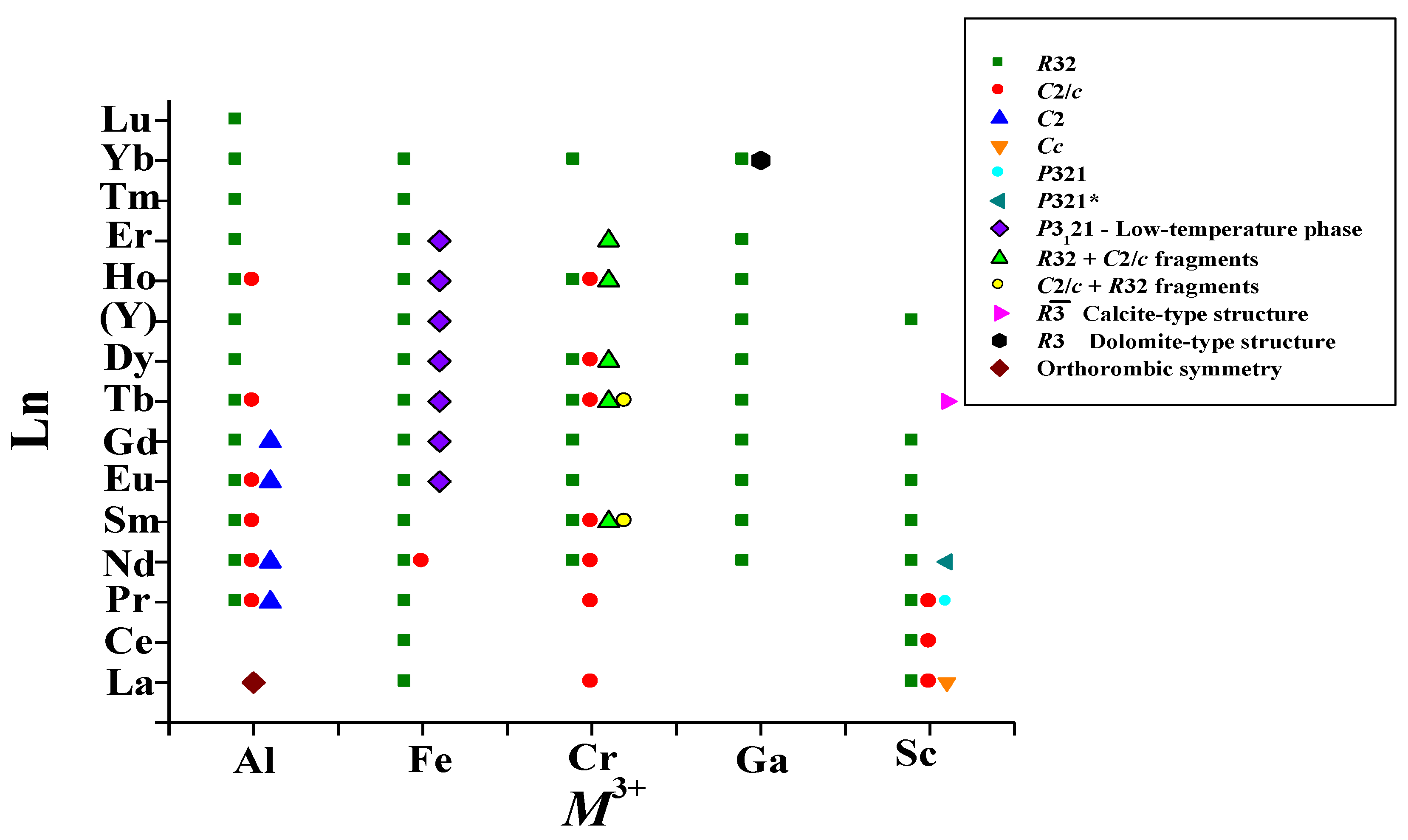
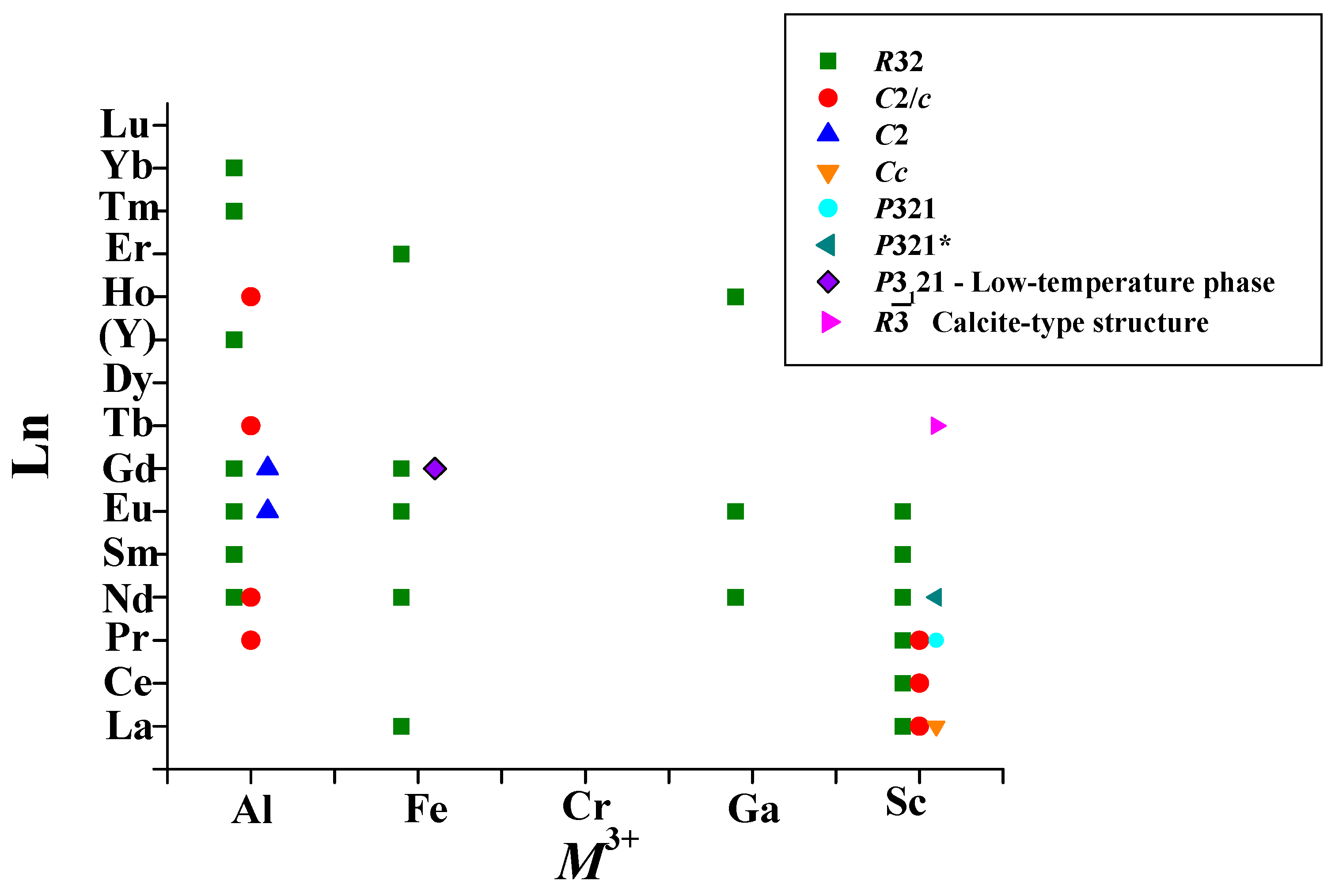

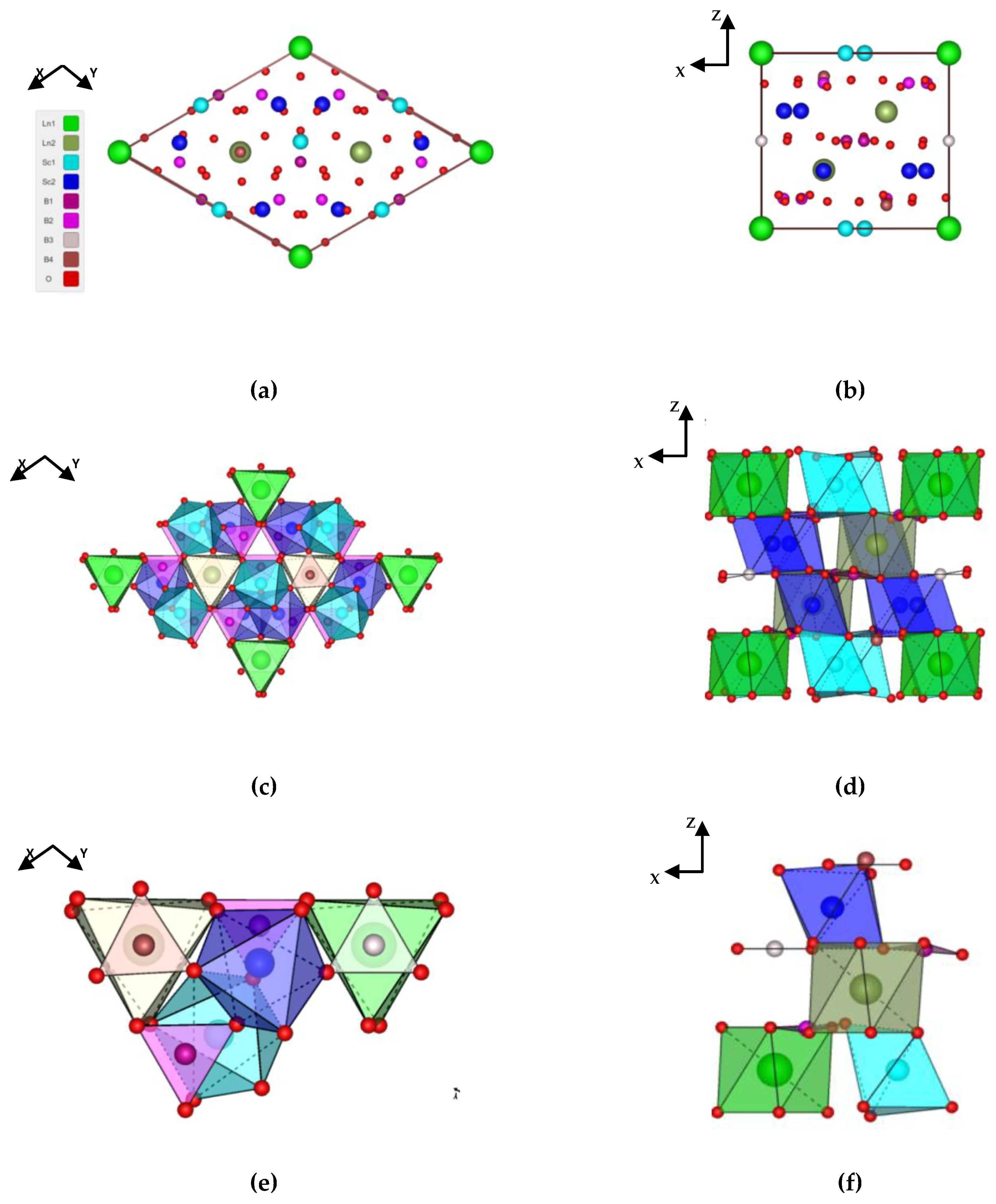
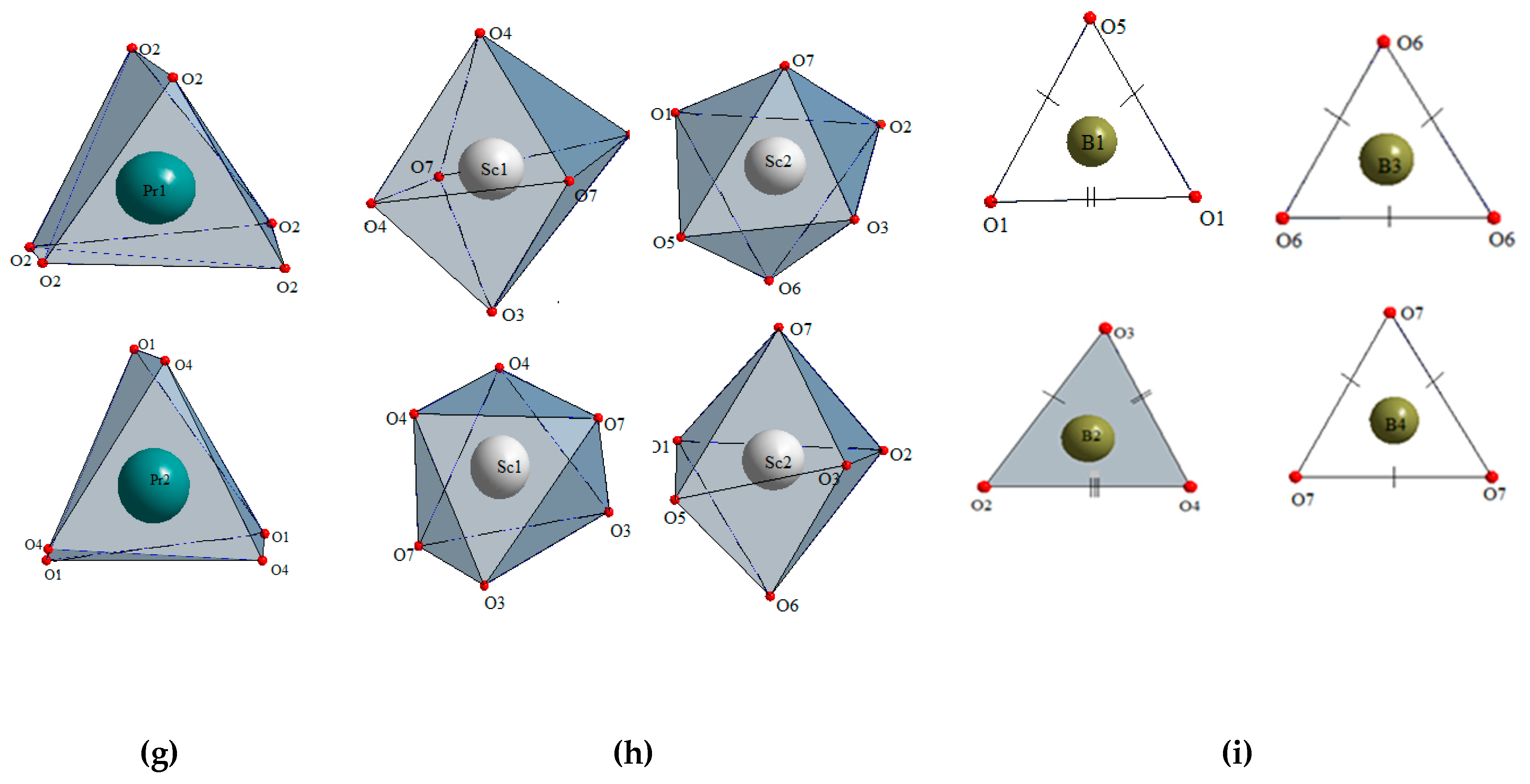
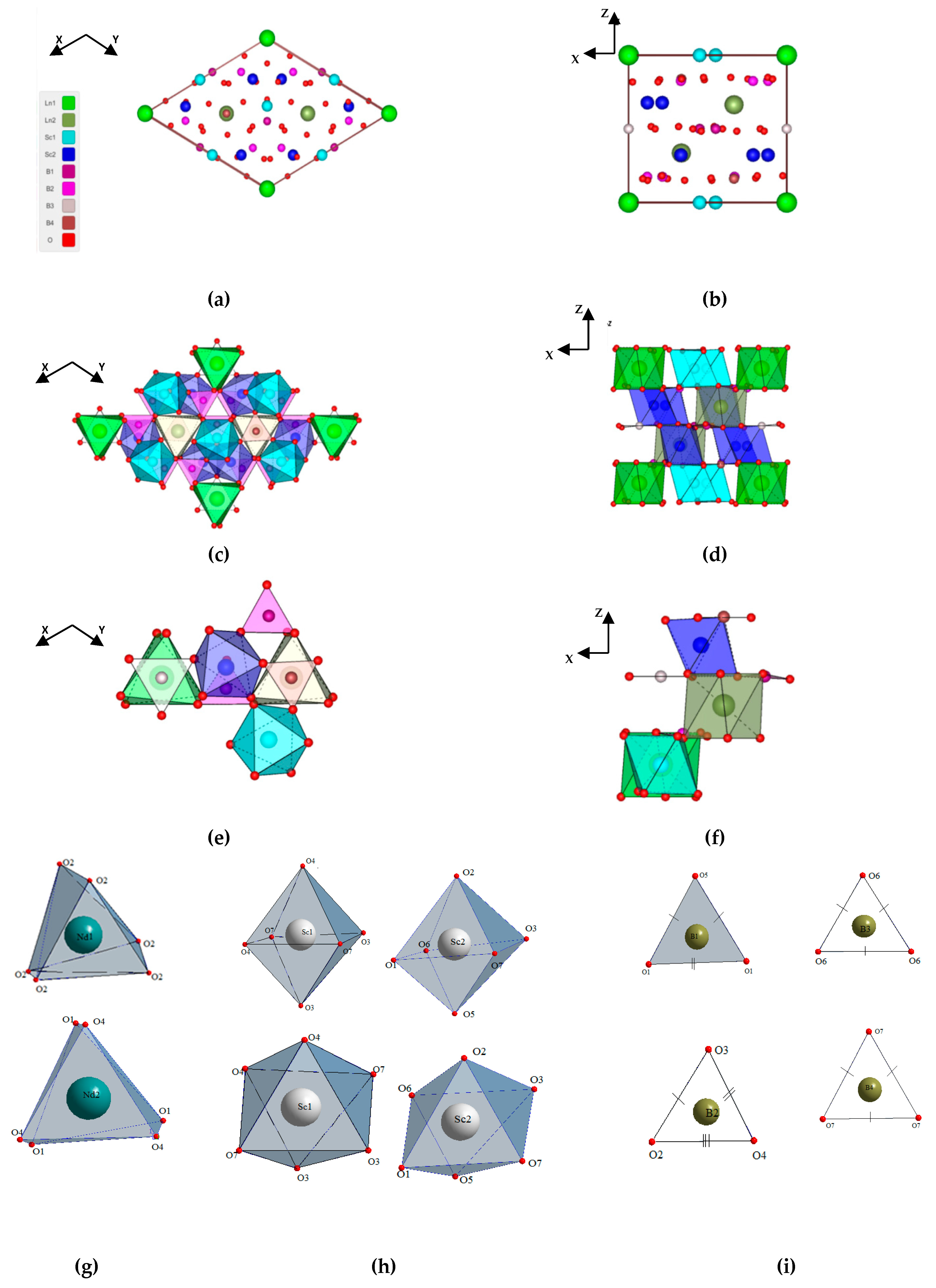

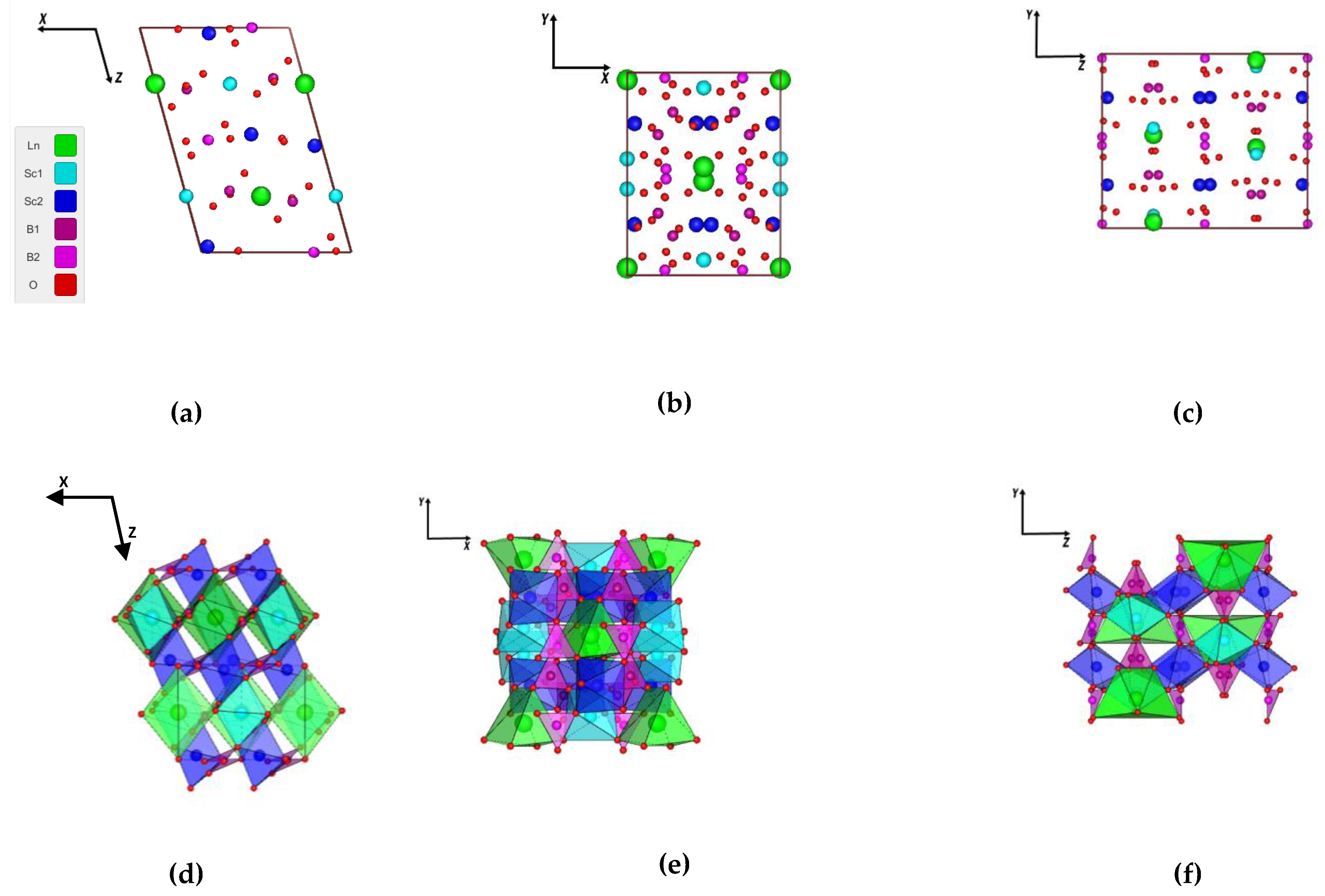

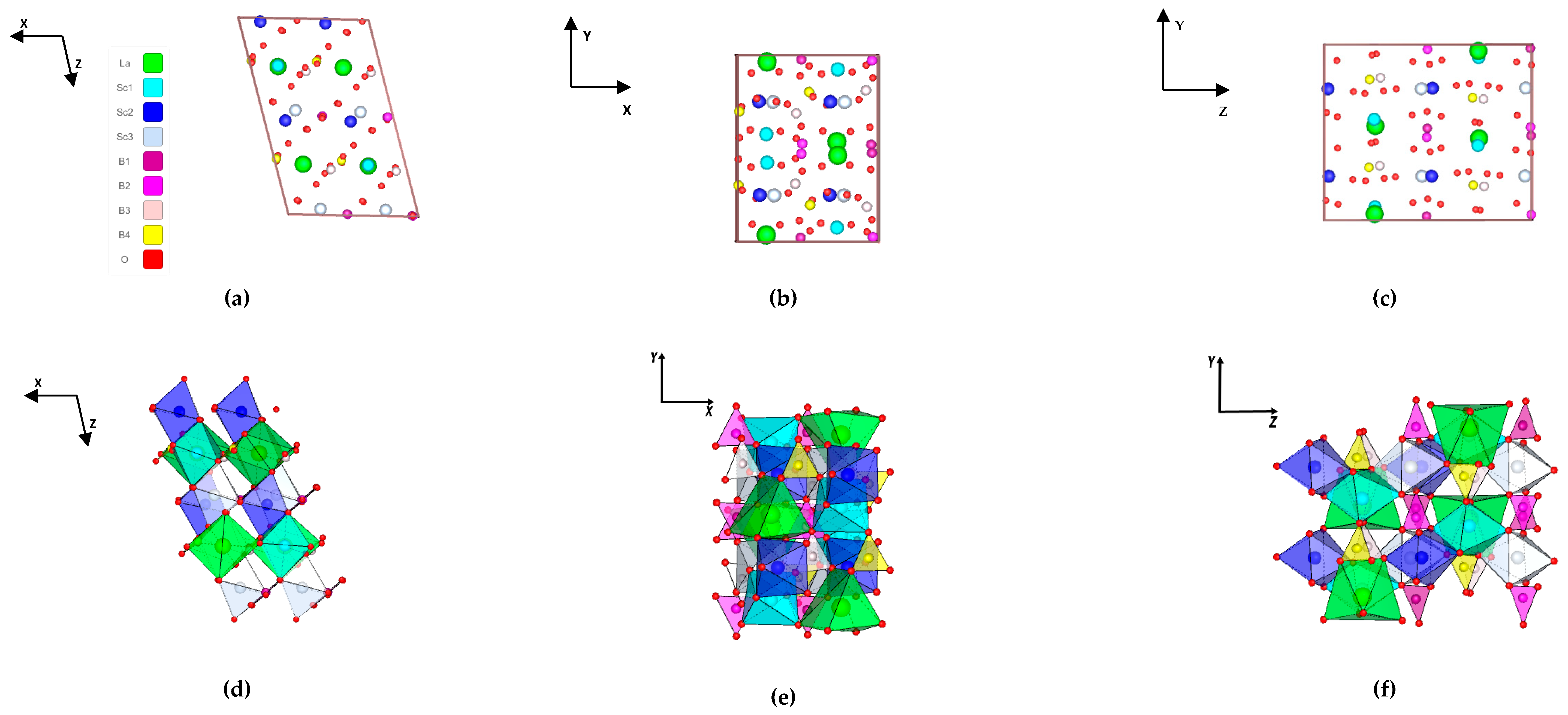
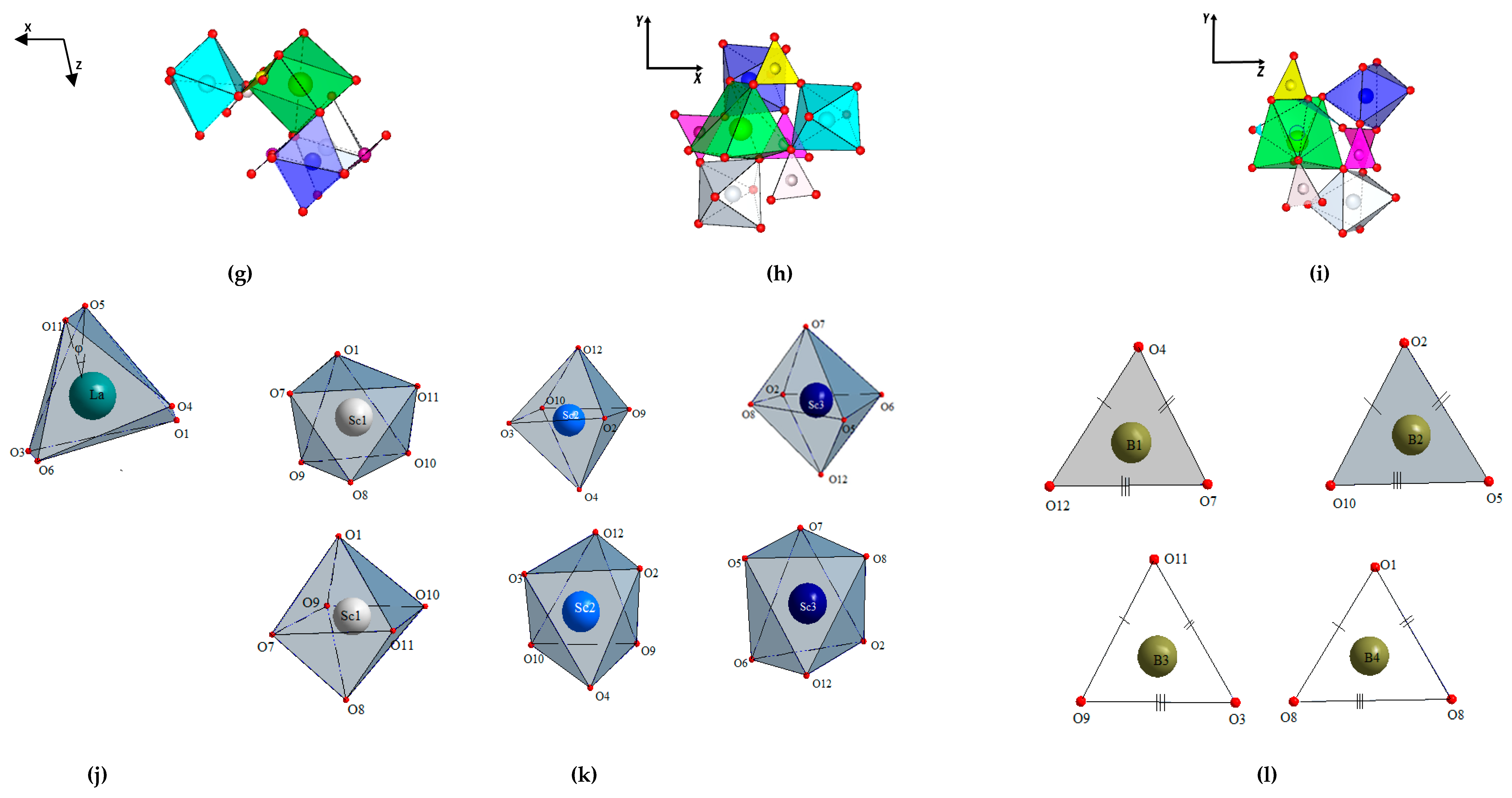
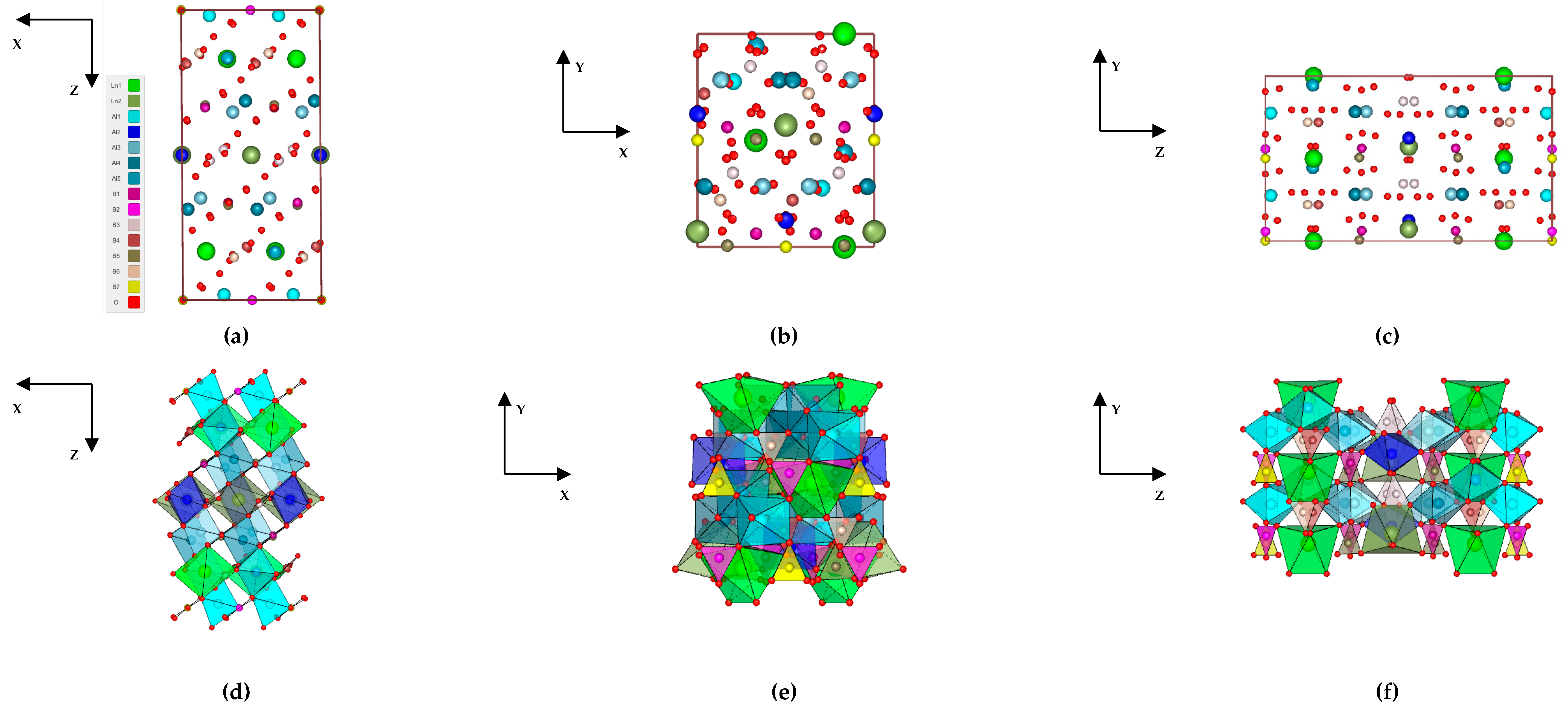
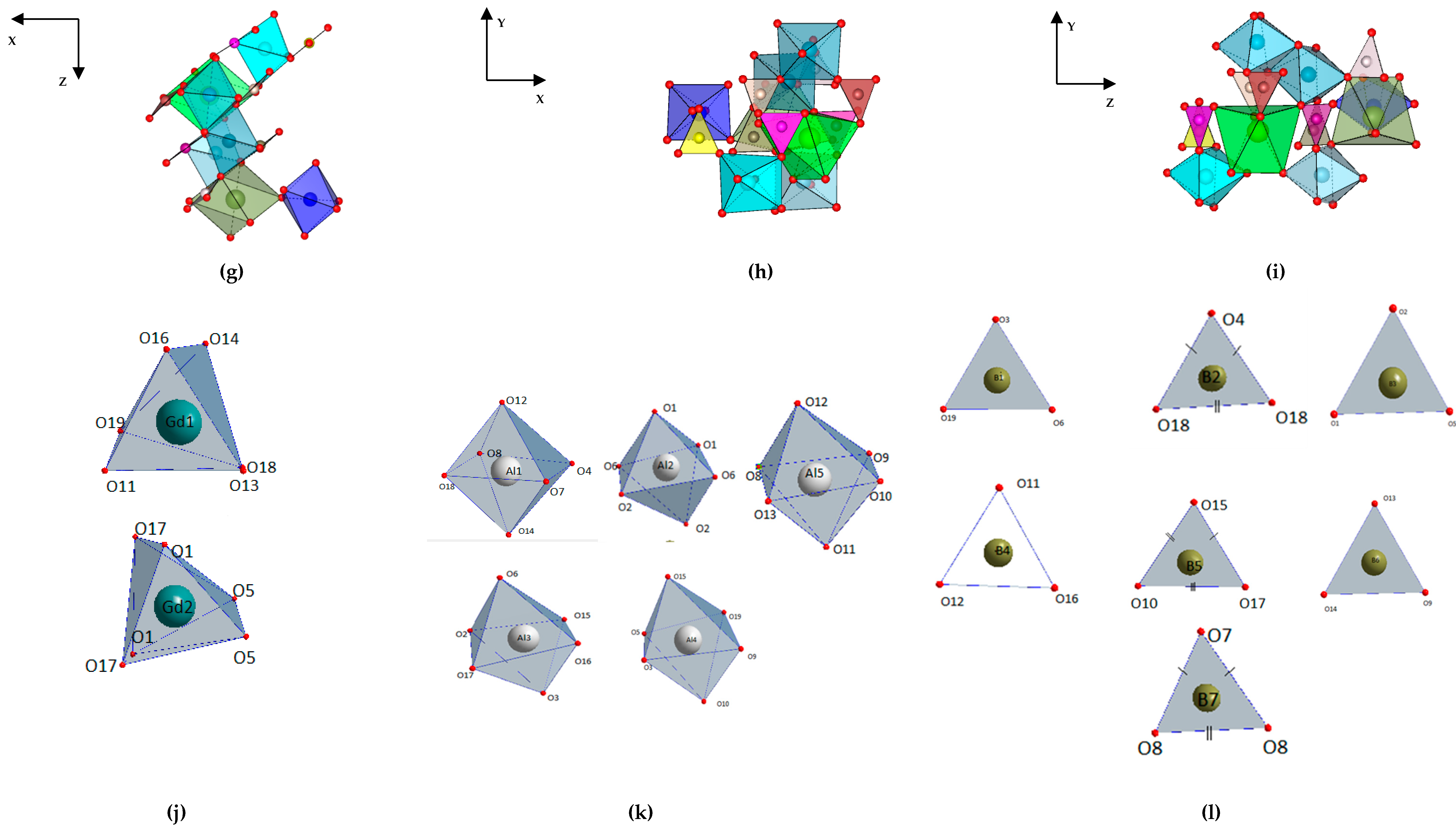

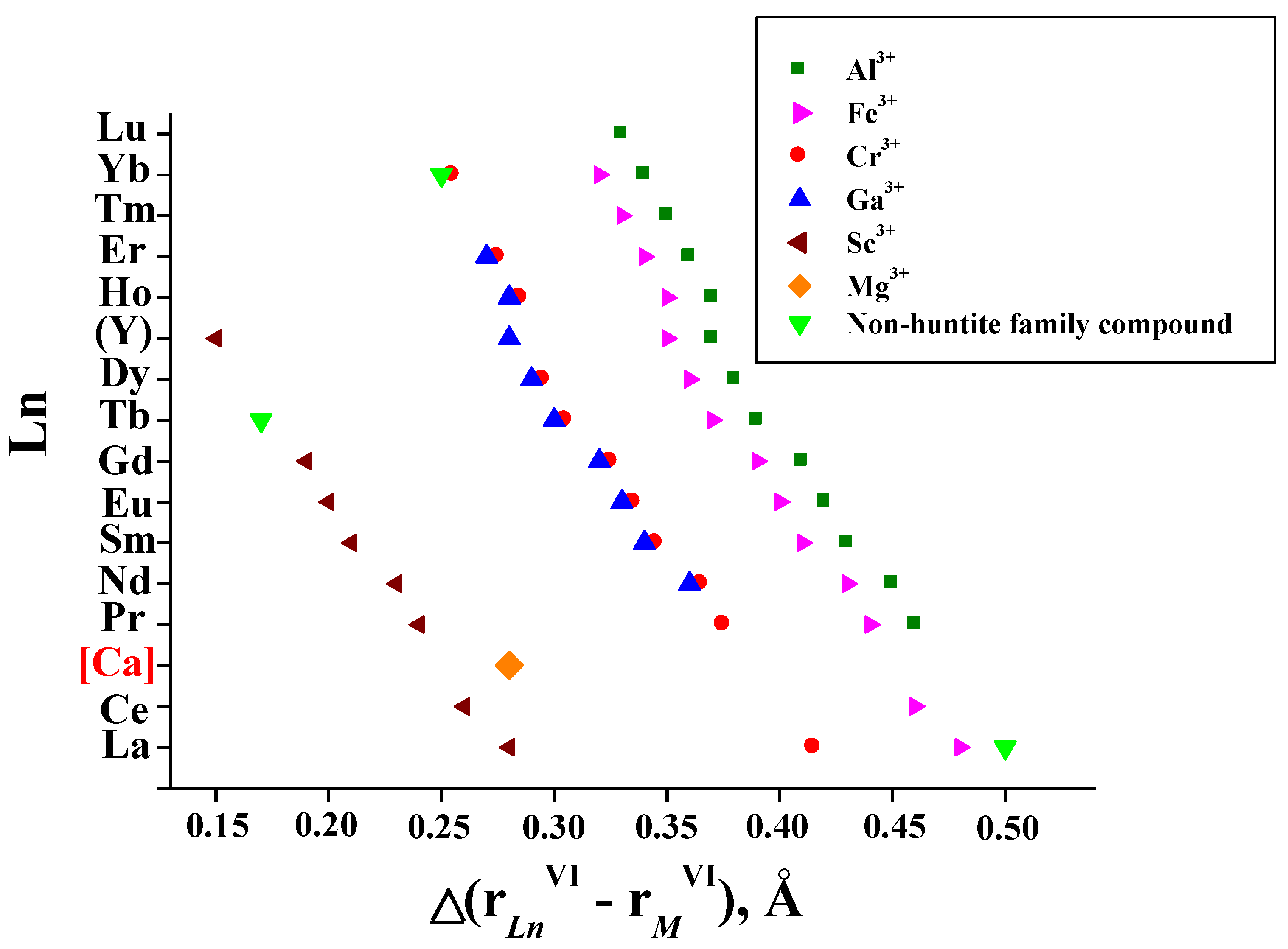
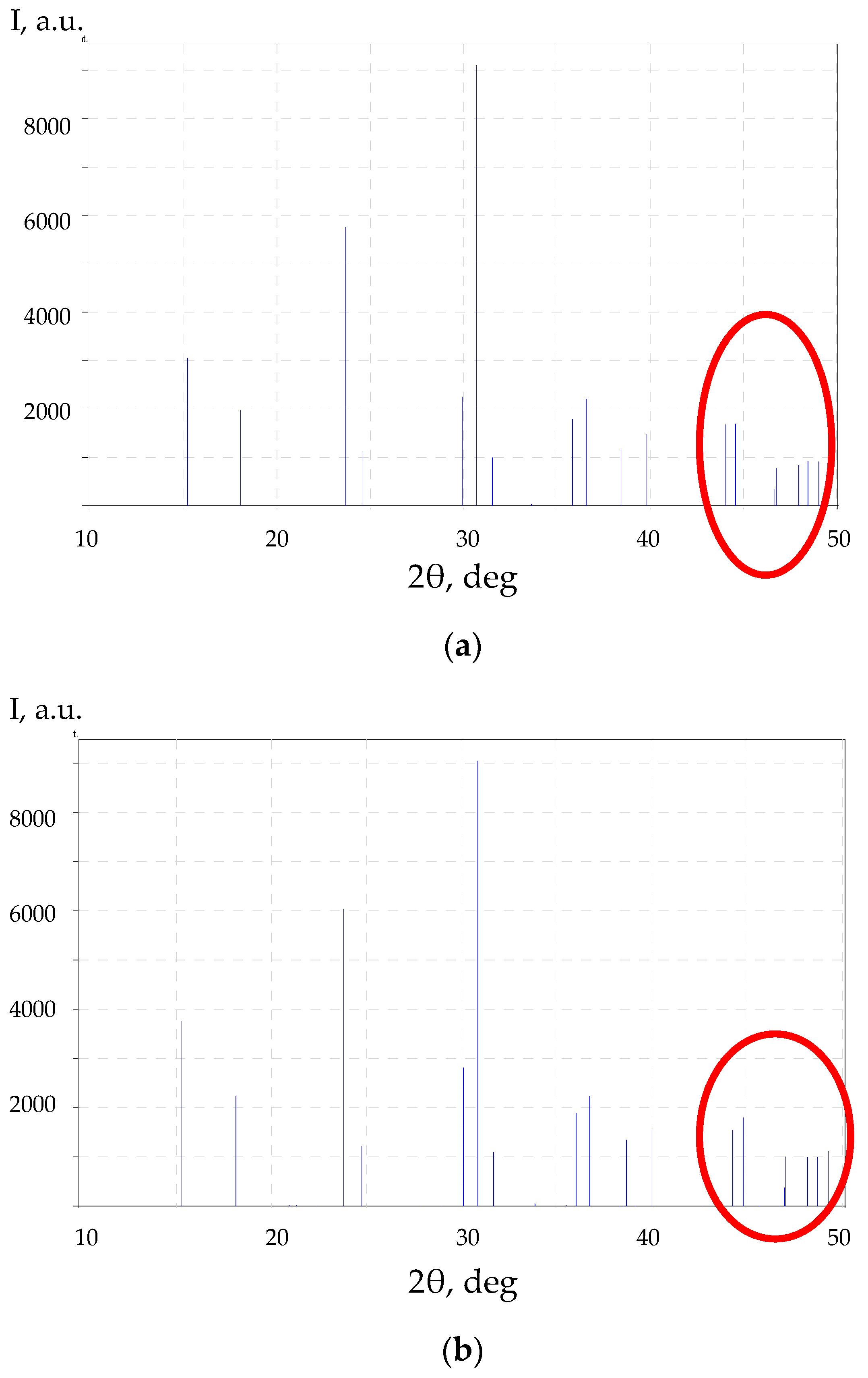
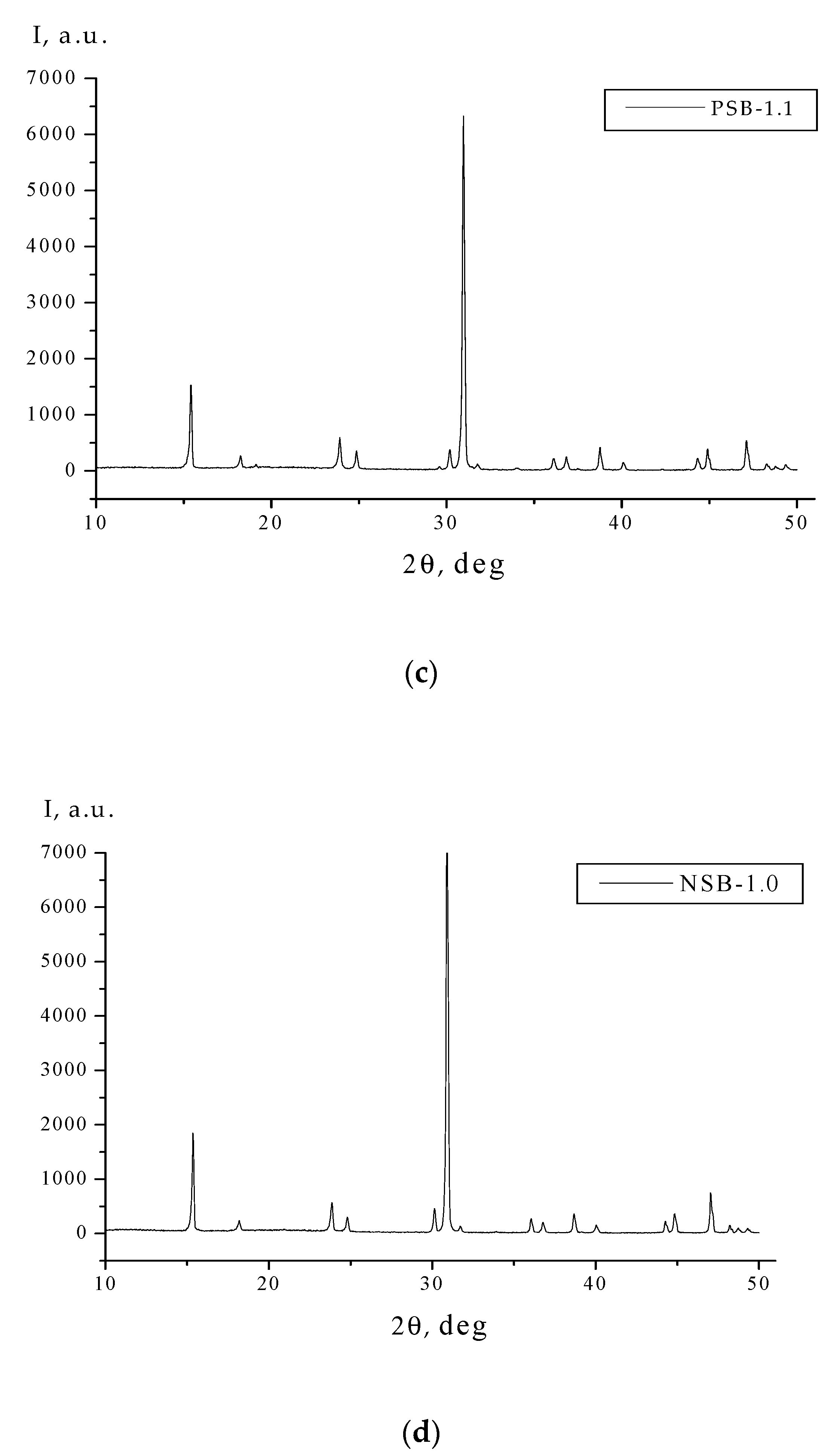

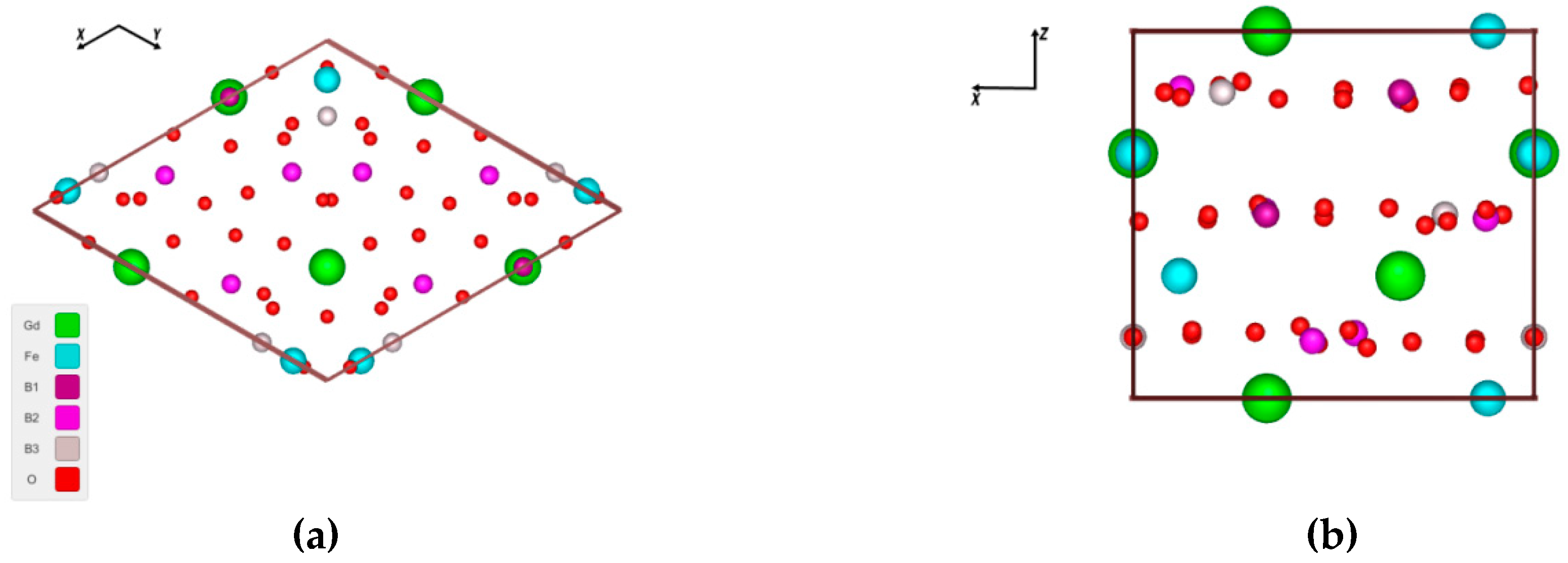

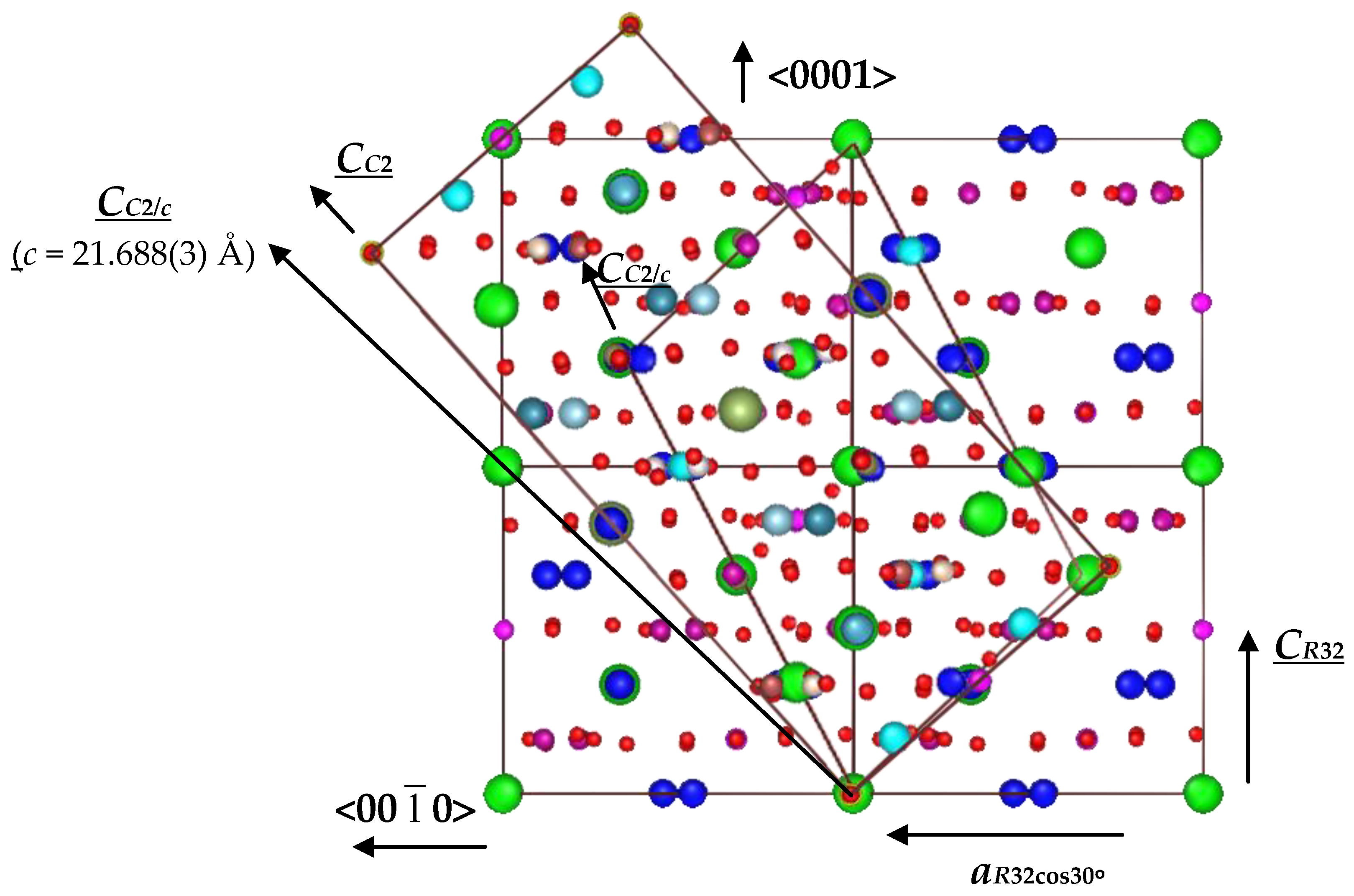
| Ln | Space groups for the LnM3(BO3)4 1 | ||||
|---|---|---|---|---|---|
| M = Al | M = Fe | M = Cr 2 | M = Ga | M = Sc | |
| La | Orthorombic symmetry: D/P [40] | R32: D/? [27], D/P [53,54], D/S [55] | C2/c: IR/S (70:30, 1040–1050 °C) [70], IR/S (1.5:1; 2.3:1) [71] | R32: D/S [74,75] C2/c: D/S (or C2) [76], D/S [77], D/P [78] Cc: D/S [79] | |
| Ce | R32: D/P [53] | R32: ? [80], D/S [81] C2/c: D/S [35,77,82,83,84,85,86,87] Refined composition: CeSc3(BO3)4 [82] | |||
| Pr | R32: D/? [27] C2/c: D/? [27], D/S [41], IR/P [42] C2: D/? [27] | R32: D/? [27], D/P [53], D/P (1.5, 300 K) [56], AS/S [57,58] | C2/c: IR/S (50:50, 900–950 °C; 70:30, 1040–1050 °C) [70], IR/S (1:1; 1.5:1; 2.3:1) [71] | R32: ? [80], D/S [88] C2/c (or C2): D/S [35,83] P321: D/S (40% reflections R32) [82] Refined compositions: (Pr0.919Sc0.081(4))Sc3(BO3)4 [82], (Pr0.924Sc0.076(4))Sc3(BO3)4 [82] | |
| Nd | R32: D/P [1], D/? [27], D/S [43,44], IR/P [42,45] C2/c: D/S [46,47], IR/P [42,45], D/P [48], ? [49] C2: D/P [48], ? [49] | R32: D/? [27], D/P [53,54,59], D/S [55], R/S [60], AS/S [57,58] C2/c: IR/P [45] | R32: D/? [27], ? [15] C2/c: IR/S (50:50, 900–950 °C; 70:30, 1040–1050 °C) [70], IR/S (1:1; 2.3:1) [71], IR/S [26,45] | R32: D/S [47], D/? [27], IR/P [45] | R32: ? [80], D/S [77], D/S [88] P321 (or P3): D/S [86,87,89] P321: D/S (40% reflections R32) [82] Refined compositions: NdSc3(BO3)4 [82,89], (Nd0.910Sc0.090(20))Sc3(BO3)4 [82] |
| Sm | R32: D/P [1], D/? [27], D/S [50] C2/c: D/? [27], IR/P [42] | R32: D/? [27], D/P [53,54,61] | R32: D/? [27], IR/S (1:1) [71], IR/S (50:50, 900–950 °C) [70] C2/c: IR/S (70:30, 1040–1050 °C) [70], IR/S [72] R32 + C2/c fragments: IR/S (1.5:1) [71] C2/c + R32: IR/S (2.3:1) [71] | R32: D/? [27], D/P [34] | R32: ? [80], D/S [88] |
| Eu | R32: D/P [1], D/? [27], D/S [50], IR/P [42,51] C2/c: D/? [27] C2: D/S [41] | R32: D/? [27], D/S [62], D/P [53,54], IR/P [51] R32 (HT) and P3121 (LT): SH/S, Ts = 88 K [53]; AS/S, Ts = 58 K [57,58]; TS/S, Ts = 84 K [62] | R32: D/? [27], D/P [16] IR/S (50:50, 900–950 °C; 70:30, 1040–1050 °C) [70], IR/S (1:1; 2.3:1) [71], IR/S [51] | R32: D/? [27], D/S [73], IR/P [51,73] | R32: D/S [88] |
| Gd | R32: D/P [1], D/? [27], D/S [50], D/P [52], IR/P [42,45] C2: D/S [46,47] | R32: D/? [27], D/P [34,54], D/S (297 K) [63], IR/P [45], P3121: D/S (90 K) [63] R32 (HT) and P3121 (LT): SH/S, Ts = 174 K [53]; R/S, Ts = 155 K [60]; AS/S, Ts = 133–156 K [57,58,64]; IR/S, Ts = 143 K [65] | R32: D/P [1], D/? [27], IR/S (50:50, 900–950 °C; 70:30, 1040–1050 °C) [70], IR/S (1:1; 1.5:1; 2.3:1) [71], IR/S [26,45] | R32: D/? [27], D/P [34,54], IR/P [45] | R32: ? [36,37] |
| Tb | R32: D/P [1], D/? [27], IR/P [42] C2/c: D/S [41] | R32: D/? [27], D/P [53,54], D/P (200 K, 300 K) [66] P3121: D/P (2, 30, 40, 100 K) [66] R32 (HT) and P3121 (LT) SH/S, Ts = 241 K [53]; R/S, Ts = 198 K [60]; AS/S, Ts = 198 K [57,58], Ts = 192 K [66]; IR/S, Ts = 200 K [65] | R32: D/? [27], IR/S (50:50, 900–950 °C) [70] R32 + C2/c fragments: IR/S (1:1) [71] C2/c + R32 fragments: IR/S (1.5:1) [71] C2/c: IR/S (70:30, 1040–1050 °C) [70], IR/S (2.3:1) [71] | R32: D/? [27] | or R3-Calcite-type structure: D/S [35,83] Refined composition: (Tb0.25Sc0.75)BO3 [83] |
| Dy | R32: D/P [1], D/? [27], IR/P [42] | R32: D/? [27], D/P [53,54], P3121: D/P (1.5, 50, 300 K) [67] R32 (HT) and P3121 (LT): SH/S, Ts = 340 K [53] | R32: IR/S (50:50, 900–950 °C) [70], IR/S (1.5:1) [71] R32 + C2/c fragments: IR/S (1:1) [71] C2/c: IR/S (70:30, 1040–1050 °C) [70], IR/S (2.3:1) [71] | R32: D/? [27] | |
| (Y) | R32: D/P [1], D/S [46,47], D/? [27], IR/P [42,45] | R32: D/? [27], D/P [53,54], IR/P [45], D/P (520 K) [68] P3121: D/P (2, 50, 295 K) [68] R32 (HT) and P3121 (LT): DTA/S, Ts = 445 K [53]; R/S, Ts = 350 K [60]; AS/S, Ts = 350 K [57,58] | R32: D/? [27], D/P [34], IR/P [45] | R32: ? [36,37] | |
| Ho | R32: D/P [1], D/? [27], IR/P [42] C2/c: D/S [41] | R32: D/? [27], D/P [53,54], D/P (520 K) [68] P3121: D/P (2, 50, 295 K) [68] R32 (HT) and P3121 (LT): DTA/S, Ts = 427 K [53] | R32: D/? [27] R32 + C2/c fragments: IR/S (1.5:1) [71], C2/c: IR/S (70:30, 1040–1050 °C) [70], IR/S (2.3:1) [71] | R32: D/? [27], D/S [73], D/P [34], IR/P [73] | |
| Er | R32: D/P [1], D/? [27], IR/P [42] | R32: D/? [27], D/S [69] P3121: D/P (1.5, 300 K) [56] R32 (HT) and P3121 (LT): R/S, Ts = 340 K [60]; AS/S, Ts = 340 K [57,58] | R32 + C2/c fragments: IR/S (1:1) [71] | R32: D/? [27], D/P [34] | |
| Tm | R32: D/? [27], D/S [41], IR/P [42] | R32: D/? [27] | |||
| Yb | R32: D/P [1], D/? [27], D/S [41], IR/P [42] | R32: D/? [27] | R32: D/? [27] | R32: D/? [27] R3-Dolomite type structure: D/P [34] | |
| Lu | R32: D/? [27] | ||||
| Initial Composition | Synthesis Method 1 | Space Group | Refined Composition (Method) 2 | Unit Cell Parameters, a, c, Å | Reference |
|---|---|---|---|---|---|
| LaSc3(BO3)4-NdSc3(BO3)4 System | |||||
| (La1−xNdx)Sc3(BO3)4 (x = 1.0) | SSR and Flux | R32 | [25] | ||
| (La1−xNdx)Sc3(BO3)4 (x ≤ 0.5) | SSR and Flux | R32 or C2/c (depending on the crystallized temperature) | [25] | ||
| (La1−xNdx)Sc3(BO3)4 (x = 0.0–0.3) | Czochralski | C2/c | [35,87] | ||
| (La1−xNdx)Sc3(BO3)4 (x ≥ 0.5) | Czochralski | R32 | [100] | ||
| LaSc3(BO3)4-«GdSc3(BO3)4»System | |||||
| LaxGd1−xSc3(BO3)4 (0.20 ≤ x ≤ 0.80) | SSR | R32 | [101,102] | ||
| La1−xGdxSc3(BO3)4 (0.3 ≤ x ≤ 0.7) | Flux | R32 | [88] | ||
| La1−xGdxSc3(BO3)4 (x ≥ 0.3) | SSR | R32 | [103,104] | ||
| La0.6Gd0.4Sc3(BO3)4, | TSSG | R32 | La0.77Gd0.22Sc3.01(BO3)4 | [101] | |
| La0.4Gd0.6Sc3(BO3)4, | TSSG | R32 | La0.64Gd0.35Sc3.01(BO3)4 (ICP) | [101] | |
| La0.2Gd0.8Sc3(BO3)4 | TSSG | R32 | La0.46Gd0.56Sc2.98(BO3)4 (ICP) | [101] | |
| LaxGd1−xSc3(BO3)4 | TSSG | R32 | La0.78Gd0.22Sc3(BO3)4 (ICP) | 9.7933 7.9540 | [101] |
| La0.678Gd0.572Sc2.75(BO3)4 | Czochralski | R32 | La0.64Gd0.41Sc2.95(BO3)4 (ICP) | 9.794(4) 7.961(6) | [103] |
| La0.75Gd0.5Sc2.75(BO3)4 | Czochralski | R32 | 9.791 7.952 | [104] | |
| LaSc3(BO3)4-«YSc3(BO3)4»System | |||||
| YxLayScz(BO3)4 (0.29 < x < 0.67, 0.67 < y < 0.82, 2.64 < z < 3.00) | SSR | R32 | [31,102,105] | ||
| La0.77Y0.28Sc2.95(BO3)4, La0.76Y0.32Sc2.92(BO3)4, La0.80Y0.38Sc2.82(BO3)4, La0.73Y0.42Sc2.85(BO3)4, La0.75Y0.47Sc2.78(BO3)4 | TSSG | R32 | [31,102,105] | ||
| Y2O3:La2O3:Sc2O3:B2O3:Li2O = 0.6:0.35:1.5:7:7.5 | TSSG | R32 | La0.72Y0.57Sc2.71(BO3)4 (ICP) | 9.774(1) 7.944(3) | [31,102,105,106,107] |
| YxLa1−xScz(BO3)4 | Flux | R32 | La0.75Y0.25Sc3(BO3)4 (XRPD) | 9.805(3) 7.980(2) | [108] |
| La0.72Y0.57Sc2.71(BO3)4 | TSSG | R32 | La0.826Y0.334Sc2.84(BO3)4 (ICP) | 9.8185 7.9893 | [109] |
| LaSc3(BO3)4-«ErSc3(BO3)4»System | |||||
| LaEr0.006Sc2.994(BO3)3.8 LaEr0.015Sc2.985(BO3)3.8 | Czochralski | C2/c | [35] | ||
| LaSc3(BO3)4-«YbSc3(BO3)4»System | |||||
| LaYb0.15Sc2.85(BO3)3.8, LaYb0.3Sc2.7(BO3)3.8, LaYb0.36Sc2.64(BO3)3.8 | Czochralski | C2/c | [35] | ||
| LaSc3(BO3)4-«LuSc3(BO3)4»System | |||||
| LaxLuyScz(BO3)4 (x + y + z = 4) | TSSG | R32 | (Lu0.05La0.95)(Lu0.61Sc2.39)(BO3)4 ≡ La0.95Lu0.66Sc2.39(BO3)4 (ICP) | 9.87420(10) 8.0696(7) | [110] |
| LaSc3(BO3)4-«BiSc3(BO3)4»System | |||||
| LaxBiyScz(BO3)4 (0.27 < x < 0.52 0.67 < y < 0.82 2.74 < z < 2.95) | SSR | R32 | [111] | ||
| La2O3 : Sc2O3 : Bi2O3 : B2O3 =1 : 1.5 : 13 : 13 | Flux | R32 | La0.82Bi0.27Sc2.91(BO3)4 (ICP) | 9.828(4) 7.989(7) | [111] |
| La2O3 : Sc2O3 : Bi2O3 : B2O3 = 1 : 1.5 : 13 : 13 | Flux | R32 | La0.91Bi0.21Sc2.88(BO3)4 (EDS) | 9.8370(14) 7.9860(14) | [112] |
| CeSc3(BO3)4-NdSc3(BO3)4System | |||||
| Ce0.53Nd0.64Sc2.83(BO3)4 | Czochralski | P321 | (Ce0.5Nd0.5(1))Sc3(BO3)4 (XRD; P321 3) | [35] | |
| CeSc3(BO3)4-«GdSc3(BO3)4»System | |||||
| (Ce0.7Gd0.3)Sc3(BO3)4 | Czochralski | P321 | present work | ||
| (Ce0.8Gd0.2)Sc3(BO3)4 | Czochralski | P321 | (Ce0.485(3)Gd0.009Sc0.006))(Ce0.465(6)Gd0.017Sc0.018)Sc3(BO3)4 (XRD; P321 3)(Ce0.803(2)Gd0.091(4)Sc0.106(4))Sc3(BO3)4 (XRD; R32 3) | 9.7812(10) 7.9480(12) | present work |
| Ce0.9Gd0.35Sc2.75(BO3)4 | Czochralski | P321 | (Ce0.949(1)Gd0.024(1)Sc0.027(1))Sc3(BO3)4 (XRD; R32 3) | 9.7776(42) 7.9436(21) | present work |
| CeSc3(BO3)4-«YSc3(BO3)4» System | |||||
| Ce1.25Y0.3Sc2.45(BO3)4 | Czochralski | P321 | (Ce0.78Y0.22(2))Sc3(BO3)4 (XRPD; R32 3) | [35] | |
| Ce1.25Y0.3Sc2.45(BO3)4 | Czochralski | P321 | (Ce0.995(1)Y0.002(1)Sc0.003(1))Sc3(BO3)4 (XRD; R32 3) | 9.7553(25) 7.9680(12) | present work |
| CeSc3(BO3)4-«LuSc3(BO3)4» System | |||||
| Ce1.25Lu0.3Sc2.45(BO3)4 | Czochralski | P321 | Ce(Lu0.17(1)Sc2.83)(BO3)4 (XRPD; R32 3) | [35] | |
| Ce1.25Lu0.3Sc2.45(BO3)4 | Czochralski | P321 | Ce(Sc2.910(30)Lu0.090)(BO3)4 (XRD; R32 3) | 9.8085(21) 7.9829(10) | present work |
| PrSc3(BO3)4-NdSc3(BO3)4»System | |||||
| Pr0.99Nd0.11Sc2.9(BO3)4 | Czochralski | P321 | [83] | ||
| PrSc3(BO3)4-«YSc3(BO3)4»System | |||||
| Nd2O3 : Y2O3 : Sc2O3 : HBO2 : Li2(CO3) : LiF = 0.25 : 0.25 : 0.8 : 2.75 : 0.177 : 0.246 | TSSG | R32 | Pr0.94Y0.09Sc2.97(BO3)4 (SEM/EDX) (periphery part) Pr0.93Y0.10Sc2.96(BO3)4 (SEM/EDX) (central part) | 9.8256(5) 7.9038(4) 9.8179(6) 7.9029(1) | [113] |
| NdSc3(BO3)4-«GdSc3(BO3)4»System | |||||
| Nd1.125Gd0.125Sc2.75(BO3)4 | Czochralski | P321 | (Nd0.8Gd0.2(1))Sc3(BO3)4 (XRD; P321 3) | [35] | |
| NdSc3(BO3)4-«YSc3(BO3)4»System | |||||
| Pr2O3 : Y2O3 : Sc2O3 : HBO2 : Li2(CO3) : LiF = 0.125 : 0.125 : 0.5 : 1.94 : 0.221 : 0.205 | TSSG | R32 | Nd0.86Y0.21Sc2.93(BO3)4 (SEM/EDX) (periphery part) Nd0.87Y0.18Sc2.95(BO3)4 (SEM/EDX) (part under the seed) | 9.7588(5) 7.9186(9) 9.7631(3)7.9210(7) | [113] |
| CeSc3(BO3)4-NdSc3(BO3)4-«GdSc3(BO3)4»System | |||||
| (Ce0.65Nd0.25Gd0.10)Sc3(BO3)4 | Czochralski | P321 | (Ce0.41(4)Nd0.46Gd0.13)Sc3(BO3)4 (XRD; R32 3) | [35] | |
| Ce0.76Nd0.30Gd0.14Sc2.8(BO3)4 | Czochralski | P321 | (Ce0.57Nd0.25Gd0.18)Sc3(BO3)4 (XRD; P321 3) | [35] | |
| CeSc3(BO3)4-NdSc3(BO3)4-«LuSc3(BO3)4»System | |||||
| Ce1.2Nd0.05Lu0.3Sc2.45(BO3)4 | Czochralski | P321 | 21 reflections (space group R32): 9.776(6) 7.937(5) 18 reflections (space group A2): a′ = 7.895, b′ = 9.749, c′ = 16.817, α = 90.23°, β = 89.95°, γ = 90.18° | [35] | |
| LaSc3(BO3)4-«ErSc3(BO3)4»-«YbSc3(BO3)4»System | |||||
| LaYb0.15Er0.015Sc2.835(BO3)3.8, LaYb0.3Er0.015Sc2.685(BO3)3.8, LaYb0.3Er0.003Sc2.67(BO3)3.8, LaYb0.36Er0.015Sc2.625(BO3)3.8 | Czochralski | C2/c | [35] | ||
| Parameter | Space Group R32 | Space Group P321 | Parameter | Space Group R32 | Space Group P321 | Parameter | Space Group R32 | Space Group P321 |
|---|---|---|---|---|---|---|---|---|
| Z | 3 | μ, mm−1 | 3.90 | 3.87 | θmax, deg | 25.865 | ||
| a, Å | 9.781(1) | Refl.: read/unique | 1765/591 | 1765/1765 | wR2 | 0.0500 | 0.0753 | |
| c, Å | 7.948(1) | (I > 2σ(I)) | R1 (I > 2σ(I)) | 0.0304 | 0.0313 | |||
| V, Å3 | 658.53 | No. of parameters | 37 | 90 | S | 0.857 | 0.978 | |
| Site | Ce1/Gd1/Sc | Ce1/Gd1/Sc | Site | B2 | Site | O3 | ||
| x | 0 | 0 | x | 0.3282(4) | x | 0.3114(3) | ||
| y | 0 | 0 | y | 0.1146(5) | y | 0.2479(4) | ||
| z | 0 | 0 | z | 0.1705(5) | z | 0.1754(3) | ||
| Beq | 1.06(1) | 1.11(1) | Beq | 1.28(6) | Beq | 1.96(8) | ||
| p(Ce1/Gd1/Sc1) | 0.1338(3)/0.0152(7)/0.0177(7) | 0.1617(9)/0.0030(9)/0.0020(9) | p | 1.0 | p | 1.0 | ||
| Site | Ce2/Gd2/Sc | Site | B2 | B3 | Site | O4 | ||
| x | 1/3 | x | 0 | 0 | x | 0.4755(4) | ||
| y | 2/3 | y | 0 | 0 | y | 0.1243(3) | ||
| z | 0.66638(4) | z | 0.5 | 0.5 | z | 0.1562(3) | ||
| Beq | 1.04(1) | Beq | 1.3(1) | 1.4(2) | Beq | 1.56(5) | ||
| p(Ce2/Gd2/Sc2) | 0.155(2)/0.006(2)/0.006(2) | p | 0.16667 | 0.16667 | p | 1.0 | ||
| Site | Sc1 | Sc1 | Site | B4 | Site | O2 | O5 | |
| x | 0.2141(1) | 0.55053(9) | x | 2/3 | x | 0.58777 | 0.5989(5) | |
| y | 1/3 | 0 | y | 1/3 | y | 0 | 0 | |
| z | 1/3 | 0 | z | 0.8473(6) | z | 0.5 | 0.5 | |
| Beq | 0.92(3) | 0.92(2) | Beq | 0.82(9) | Beq | 2.4(1) | 2.02(8) | |
| p | 0.5 | 0.5 | p | 0.3333 | p | 0.5 | 0.5 | |
| Site | Sc2 | Site | O1 | Site | O3 | O6 | ||
| x | 0.21195(9) | x | 0.4560(3) | x | −0.1399(5) | 0.1405(4) | ||
| y | 0.33235(6) | y | 0.1408(3) | y | 0 | 0.1405(4) | ||
| z | 0.32954(6) | z | 0.5228(3) | z | 0.5 | 0.5 | ||
| Beq | 0.86(2) | Beq | 1.44(5) | Beq | 1.54(8) | 1.22(4) | ||
| p | 1.0 | p | 1.0 | p | 0.5 | 0.5 | ||
| Site | B1 | B1 | Site | O1 | O2 | Site | O7 | |
| x | 0.4516(6) | 0.4536(5) | x | 0.0193(4) | 0.1930(4) | x | 0.6745(3) | |
| y | 0 | 0 | y | 0.2116(4) | −0.0209(3) | y | 0.1983(3) | |
| z | 0.5 | 0.5 | z | 0.1813(4) | 0.1769(3) | z | −0.1536(2) | |
| Beq | 1.30(8) | 1.05(8) | Beq | 1.58(6) | 1.51(5) | Beq | 1.22(4) | |
| p | 0.16667 | 0.5 | p | 1.0 | 1.0 | p | 1.0 | |
| Parameter | Space Group R32 | Parameter | Space Group P321 |
|---|---|---|---|
| Ce1/Gd1/Sc | Ce1/Gd1/Sc | ||
| – 6 × O1 | 2.450(3) | – 6 × O2 | 2.443(3) |
| Ce2/Gd2/Sc | |||
| – 3 × O4 | 2.417(3) | ||
| – 3 × O1 | 2.484(3) | ||
| [Ce2/Gd2/Sc-O]av. | 2.4505 | ||
| Sc1 | Sc1 | ||
| – 2 × O1 | 2.059(3) | – 2 × O7 | 2.091(3) |
| – 2 × O3 | 2.118(3) | – 2 × O4 | 2.110(3) |
| – 2 × O2 | 2.148(4) | – 2 × O3 | 2.211(3) |
| [Sc1-O]av. | 2.129 | [Sc1-O]av. | 2.134 |
| Sc2 | |||
| – 1 × O2 | 2.035(3) | ||
| – 1 × O1 | 2.041(3) | ||
| – 1 × O5 | 2.113(3) | ||
| – 1 × O3 | 2.124(3) | ||
| – 1 × O6 | 2.129(2) | ||
| – 1 × O7 | 2.149(2) | ||
| [Sc2-O]av. | 2.0985 | ||
| B1 | B1 | ||
| – 1 × O2 | 1.33(1) | – 2 × O1 | 1.378(4) |
| – 2 × O1 | 1.368(5) | – 1 × O5 | 1.412(8) |
| 1.355 | [B1-O]av. | 1.389 | |
| B2 | |||
| – 1 × O3 | 1.289(6) | ||
| – 1 × O2 | 1.325(5) | ||
| – 1 × O4 | 1.401(5) | ||
| [B2-O]av. | 1.338 | ||
| B2 | B3 | ||
| – 3 × O3 | 1.369(5) | – 3 × O6 | 1.375(4) |
| B4 | |||
| – 3 × O7 | 1.360(3) |
© 2019 by the authors. Licensee MDPI, Basel, Switzerland. This article is an open access article distributed under the terms and conditions of the Creative Commons Attribution (CC BY) license (http://creativecommons.org/licenses/by/4.0/).
Share and Cite
Kuz’micheva, G.M.; Kaurova, I.A.; Rybakov, V.B.; Podbel’skiy, V.V. Crystallochemical Design of Huntite-Family Compounds. Crystals 2019, 9, 100. https://doi.org/10.3390/cryst9020100
Kuz’micheva GM, Kaurova IA, Rybakov VB, Podbel’skiy VV. Crystallochemical Design of Huntite-Family Compounds. Crystals. 2019; 9(2):100. https://doi.org/10.3390/cryst9020100
Chicago/Turabian StyleKuz’micheva, Galina M., Irina A. Kaurova, Victor B. Rybakov, and Vadim V. Podbel’skiy. 2019. "Crystallochemical Design of Huntite-Family Compounds" Crystals 9, no. 2: 100. https://doi.org/10.3390/cryst9020100
APA StyleKuz’micheva, G. M., Kaurova, I. A., Rybakov, V. B., & Podbel’skiy, V. V. (2019). Crystallochemical Design of Huntite-Family Compounds. Crystals, 9(2), 100. https://doi.org/10.3390/cryst9020100






